Intel 512ANHU Intel Wi-Fi Link 5100 Series User Manual 4
Intel Mobile Communications Intel Wi-Fi Link 5100 Series 4
Intel >
Contents
- 1. User Manual 1
- 2. User Manual 2
- 3. User Manual 3
- 4. User Manual 4
- 5. User Manual
User Manual 4
HP Mini
User Guide
© Copyright 2009 Hewlett-Packard
Development Company, L.P.
Bluetooth is a trademark owned by its
proprietor and used by Hewlett-Packard
Company under license. Microsoft and
Windows are U.S. registered trademarks of
Microsoft Corporation. SD Logo is a
trademark of its proprietor.
The information contained herein is subject
to change without notice. The only
warranties for HP products and services are
set forth in the express warranty statements
accompanying such products and services.
Nothing herein should be construed as
constituting an additional warranty. HP shall
not be liable for technical or editorial errors
or omissions contained herein.
First Edition: July 2009
Document Part Number: 538073-001
Product notice
This user guide describes features that are
common to most models. Some features
may not be available on your computer.

Safety warning notice
WARNING! To reduce the possibility of heat-related injuries or of overheating the computer, do not
place the computer directly on your lap or obstruct the computer air vents. Use the computer only on a
hard, flat surface. Do not allow another hard surface, such as an adjoining optional printer, or a soft
surface, such as pillows or rugs or clothing, to block airflow. Also, do not allow the AC adapter to contact
the skin or a soft surface, such as pillows or rugs or clothing, during operation. The computer and the
AC adapter comply with the user-accessible surface temperature limits defined by the International
Standard for Safety of Information Technology Equipment (IEC 60950).
iii
iv Safety warning notice

Table of contents
1 Features
Identifying the hardware ....................................................................................................................... 1
Top components .................................................................................................................. 1
TouchPad ............................................................................................................ 1
Lights ................................................................................................................... 3
Buttons ................................................................................................................ 4
Keys .................................................................................................................... 5
Front components ................................................................................................................ 5
Right-side components ........................................................................................................ 6
Left-side components .......................................................................................................... 7
Display components ........................................................................................................... 8
Bottom components ............................................................................................................. 8
Wireless antennas ............................................................................................................... 9
Additional hardware components ...................................................................................... 10
Identifying the labels ........................................................................................................................... 10
2 Power management
Setting power options ......................................................................................................................... 12
Using power-saving states ................................................................................................. 12
Initiating and exiting Standby ............................................................................ 12
Initiating and exiting Hibernation ....................................................................... 13
Using the Power Meter ...................................................................................................... 13
Using power schemes ....................................................................................................... 14
Viewing the current scheme .............................................................................. 14
Selecting a different power scheme .................................................................. 14
Customizing power schemes ............................................................................ 15
Setting password protection upon exiting Standby ............................................................ 15
Using external AC power .................................................................................................................... 15
Connecting the AC adapter ............................................................................................... 16
Using battery power ........................................................................................................................... 16
Displaying the remaining battery charge ........................................................................... 17
Inserting or removing the battery ....................................................................................... 17
Charging a battery ............................................................................................................. 18
Maximizing battery discharge time .................................................................................... 19
v
Managing low battery levels .............................................................................................. 19
Identifying low battery levels ............................................................................. 19
Resolving a low battery level ............................................................................. 20
Resolving a low battery level when external power is available ....... 20
Resolving a low battery level when a charged battery is
available ........................................................................................... 20
Resolving a low battery level when no power source is
available ........................................................................................... 20
Resolving a low battery level when the computer cannot exit
Hibernation ....................................................................................... 20
Calibrating a battery ........................................................................................................... 20
Step 1: Fully charge the battery ........................................................................ 20
Step 2: Disable Hibernation and Standby ......................................................... 21
Step 3: Discharge the battery ............................................................................ 21
Step 4: Fully recharge the battery ..................................................................... 22
Step 5: Reenable Hibernation and Standby ...................................................... 22
Conserving battery power .................................................................................................. 22
Storing a battery ................................................................................................................ 22
Disposing of a used battery ............................................................................................... 23
Replacing the battery ........................................................................................................ 23
Testing an AC adapter ....................................................................................................................... 24
Shutting down the computer ............................................................................................................... 24
3 Wireless
Using wireless devices (select models only) ...................................................................................... 25
Identifying wireless and network icons .............................................................................. 25
Using the wireless controls ................................................................................................ 26
Using the wireless switch ................................................................................................... 26
Using operating system controls ........................................................................................ 26
Using a WLAN .................................................................................................................................... 27
Setting up a WLAN ............................................................................................................ 27
Protecting your WLAN ....................................................................................................... 27
Connecting to a WLAN ...................................................................................................... 29
Roaming to another network .............................................................................................. 29
Using HP Mobile Broadband (select models only) ............................................................................. 30
Inserting a SIM ................................................................................................................... 30
Removing a SIM ................................................................................................................ 31
Using Bluetooth wireless devices (select models only) ...................................................................... 33
Bluetooth and Internet Connection Sharing (ICS) ............................................................. 33
4 Multimedia
Multimedia features ............................................................................................................................ 34
Identifying your multimedia components ........................................................................... 34
Adjusting the volume ......................................................................................................... 35
vi
Multimedia software ........................................................................................................................... 36
Using preinstalled multimedia software ............................................................................. 37
Installing multimedia software from a disc ......................................................................... 37
Audio .................................................................................................................................................. 38
Connecting external audio devices .................................................................................... 38
Checking your audio functions ........................................................................................... 38
Video .................................................................................................................................................. 40
Connecting an external monitor or projector ...................................................................... 40
Optical drive (select models only) ...................................................................................................... 41
Identifying the external optical drive .................................................................................. 41
Using optical discs ............................................................................................................. 41
Selecting the right disc ....................................................................................................... 41
CD-R discs ........................................................................................................ 42
CD-RW discs ..................................................................................................... 42
DVD±R discs ..................................................................................................... 42
DVD±RW discs ................................................................................................. 42
Playing music ..................................................................................................................... 42
Watching a movie .............................................................................................................. 43
Changing DVD region settings .......................................................................................... 44
Creating or “burning” a CD or DVD .................................................................................... 44
Removing an optical disc (CD or DVD) ............................................................................. 45
Webcam ............................................................................................................................................. 47
Adjusting webcam properties ............................................................................................. 47
5 Security
Protecting the computer ..................................................................................................................... 48
Using passwords ................................................................................................................................ 49
Setting passwords in Windows .......................................................................................... 49
Setting passwords in Computer Setup .............................................................................. 49
Setup password ................................................................................................................. 50
Managing a setup password ............................................................................. 51
Entering a setup password ................................................................................ 52
Power-on password ........................................................................................................... 52
Managing a power-on password ....................................................................... 53
Entering a power-on password ......................................................................... 54
Requiring a power-on password at restart ........................................................ 55
Using Computer Setup DriveLock ..................................................................................... 55
Setting a DriveLock password ........................................................................... 56
Entering a DriveLock password ........................................................................ 57
Changing a DriveLock password ...................................................................... 58
Removing DriveLock protection ........................................................................ 59
Using Computer Setup security features ............................................................................................ 60
Securing system devices ................................................................................................... 60
vii
Using Computer Setup stringent security .......................................................................... 60
Setting stringent security ................................................................................... 61
Removing stringent security .............................................................................. 62
Viewing Computer Setup System Information ................................................................... 62
Using antivirus software ..................................................................................................................... 63
Using firewall software ....................................................................................................................... 64
Installing critical updates .................................................................................................................... 65
Installing a security cable ................................................................................................................... 66
6 External devices
Using a USB device ........................................................................................................................... 67
Connecting a USB device .................................................................................................. 67
Stopping and removing a USB device ............................................................................... 67
Using USB legacy support ................................................................................................. 68
Using external drives .......................................................................................................................... 69
Using optional external devices ......................................................................................... 69
Using an optional external MultiBay II ............................................................................... 69
Using an optional external optical drive (select models only) ............................................................. 70
Inserting an optical disc (CD or DVD) ................................................................................ 70
Removing an optical disc (CD or DVD) ............................................................................. 71
When the disc tray opens .................................................................................. 71
When the disc tray does not open ..................................................................... 72
7 External media cards
Using SD Card Reader cards ............................................................................................................. 74
Inserting a digital card ........................................................................................................ 74
Stopping and removing a digital card ................................................................................ 75
8 Pointing devices and keyboard
Using pointing devices ....................................................................................................................... 76
Setting pointing device preferences ................................................................................... 76
Using the TouchPad .......................................................................................................... 76
Connecting an external mouse .......................................................................................... 76
Using the keyboard function keys ...................................................................................................... 76
Switching the screen image (f2) ........................................................................................ 78
Decreasing screen brightness (f3) ..................................................................................... 78
Increasing screen brightness (f4) ...................................................................................... 78
Initiating Standby (f5) ......................................................................................................... 78
Initiating QuickLock (f6) ..................................................................................................... 78
Muting speaker sound (f8) ................................................................................................. 79
Decreasing speaker sound (f10) ........................................................................................ 79
Increasing speaker sound (f11) ......................................................................................... 79
Using keypads .................................................................................................................................... 79
viii
Using the embedded numeric keypad ............................................................................... 79
Enabling and disabling the embedded numeric keypad .................................... 80
Switching key functions on the embedded numeric keypad ............................. 80
Using an optional external numeric keypad ....................................................................... 80
Cleaning the TouchPad and keyboard ............................................................................................... 81
9 Drives
Identifying installed drives .................................................................................................................. 82
Handling drives ................................................................................................................................... 82
Improving hard drive performance ..................................................................................................... 84
Using Disk Defragmenter ................................................................................................... 84
Using Disk Cleanup ........................................................................................................... 84
Using HP 3D DriveGuard (select models only) ................................................................................. 85
Identifying HP 3D DriveGuard status ................................................................................. 85
Using HP 3D DriveGuard software .................................................................................... 85
Replacing a hard drive ....................................................................................................................... 87
10 Memory modules
11 Computer Setup
Starting Computer Setup .................................................................................................................... 94
Using Computer Setup ....................................................................................................................... 94
Navigating and selecting in Computer Setup ..................................................................... 94
Restoring factory settings in Computer Setup ................................................................... 95
Computer Setup menus ..................................................................................................................... 95
File menu ........................................................................................................................... 95
Security menu .................................................................................................................... 96
Diagnostics menu .............................................................................................................. 96
System Configuration menu .............................................................................................. 97
12 Backing up and recovering
Backing up ........................................................................................................................................ 100
Recovering ....................................................................................................................................... 101
Index ................................................................................................................................................................. 102
ix
x
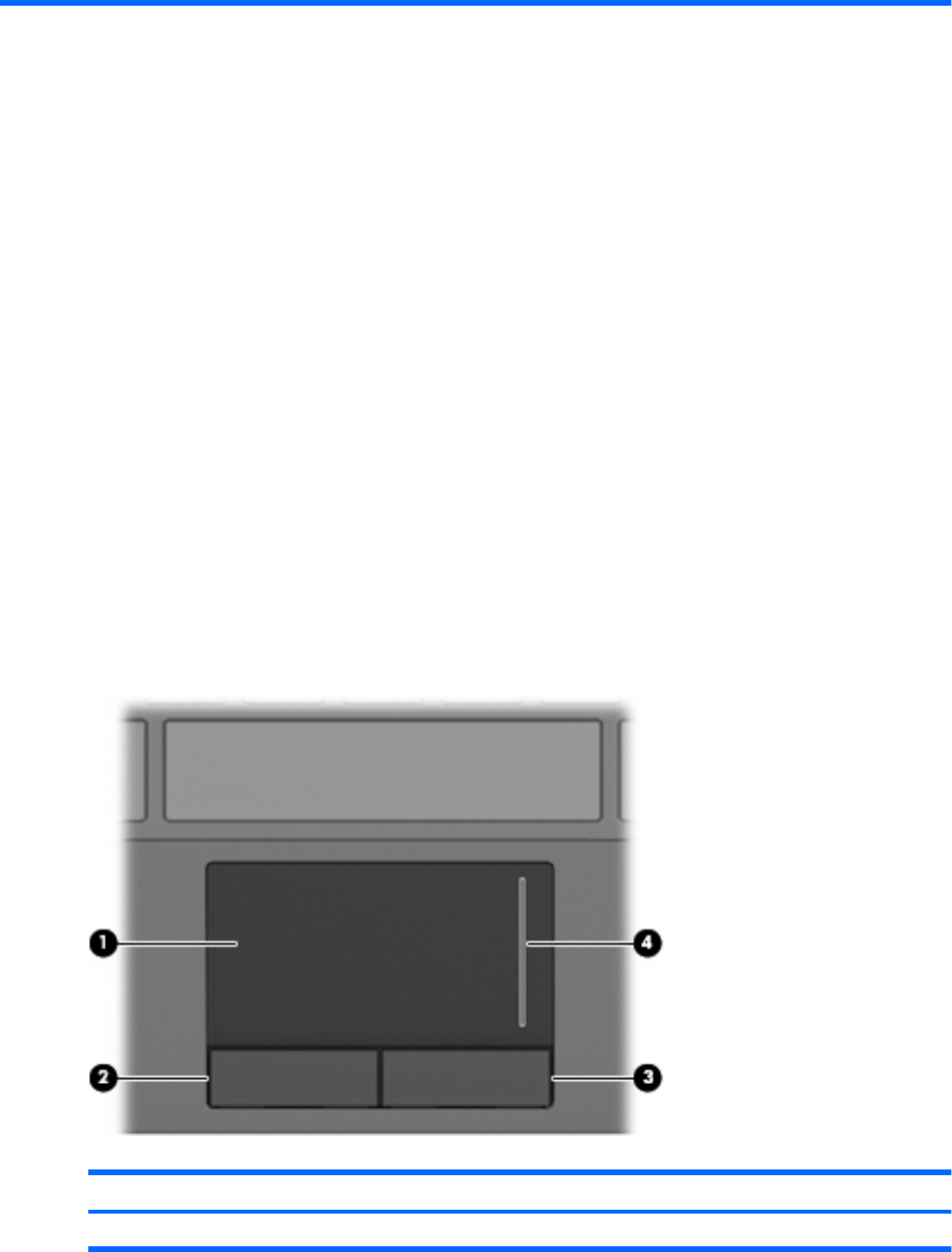
1 Features
Identifying the hardware
Components included with the computer may vary by region and model. The illustrations in this chapter
identify the standard features on most computer models.
To see a list of hardware installed in the computer, follow these steps:
1. Select Start > My Computer.
2. In the left pane of the System Tasks window, select View system information.
3. Select Hardware tab > Device Manager.
You can also add hardware or modify device configurations using Device Manager.
Top components
TouchPad
Component Description
(1) TouchPad* Moves the pointer and selects or activates items on the screen.
Identifying the hardware 1

Component Description
(2) Left TouchPad button* Functions like the left button on an external mouse.
(3) Right TouchPad button* Functions like the right button on an external mouse.
(4) TouchPad scroll zone Scrolls up or down.
*This table describes factory settings. To view or change pointing device preferences, select Start > Control Panel > Printers
and Other Hardware > Mouse.
2 Chapter 1 Features
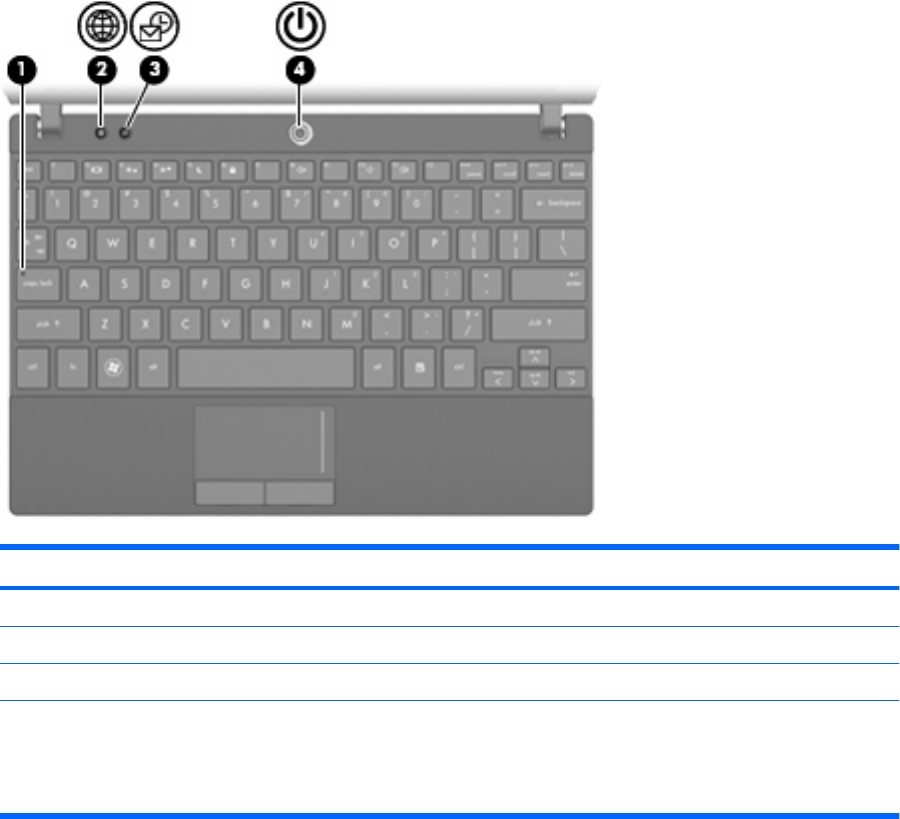
Lights
Component Description
(1) Caps lock light On: Caps lock is on.
(2) Quick Launch Web light On: The default Internet browser is being launched.
(3) Quick Launch Mail light On: The default mail application is being launched.
(4) Power light ●On: The computer is on.
●Blinking: The computer is in the Standby state.
●Off: The computer is off or in Hibernation.
Identifying the hardware 3
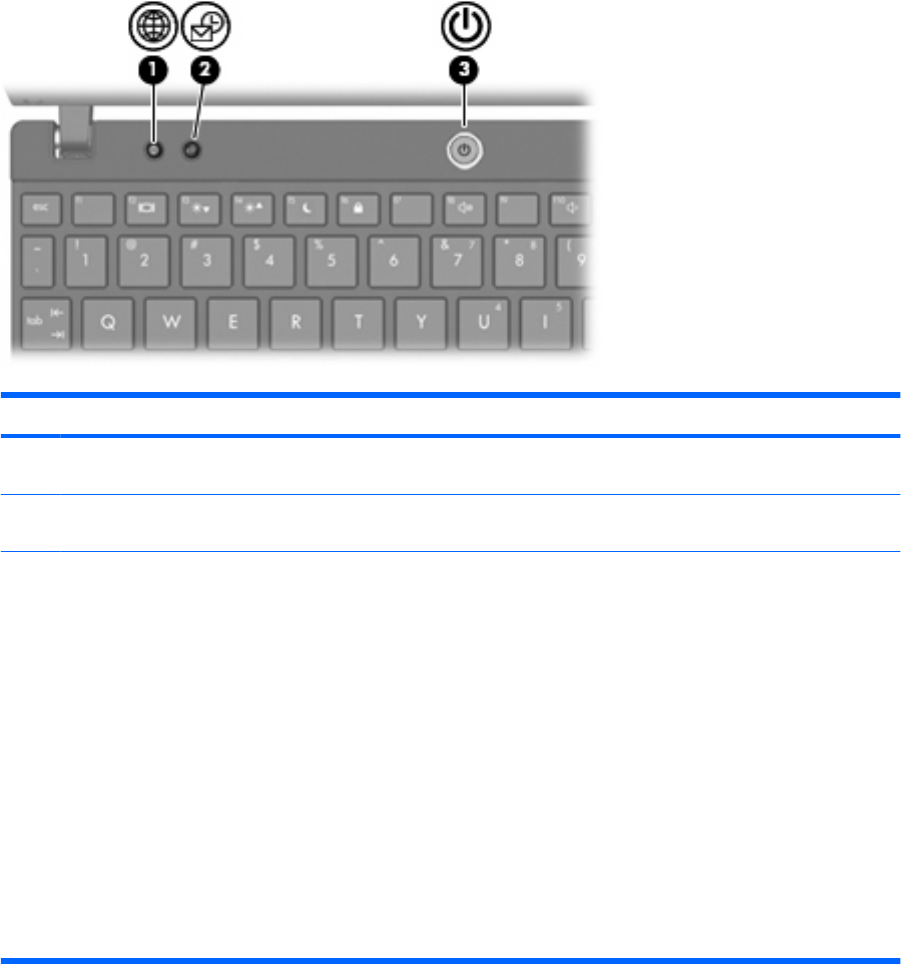
Buttons
Component Description
(1) Quick Launch Web button Opens the default Internet browser when the computer is
on.
(2) Quick Launch Mail button Opens the default mail application when the computer is
on.
(3) Power button ●When the computer is off, press the button to turn on
the computer.
●When the computer is on, press the button to shut
down the computer.
●When the computer is in the Standby state, press the
button briefly to exit Standby.
●When the computer is in Hibernation, press the
button briefly to exit Hibernation.
If the computer has stopped responding and Windows
shutdown procedures are ineffective, press and hold the
power button for at least 5 seconds to turn off the
computer.
To learn more about your power settings, select Start >
Control Panel > Performance and Maintenance >
Power Options.
4 Chapter 1 Features
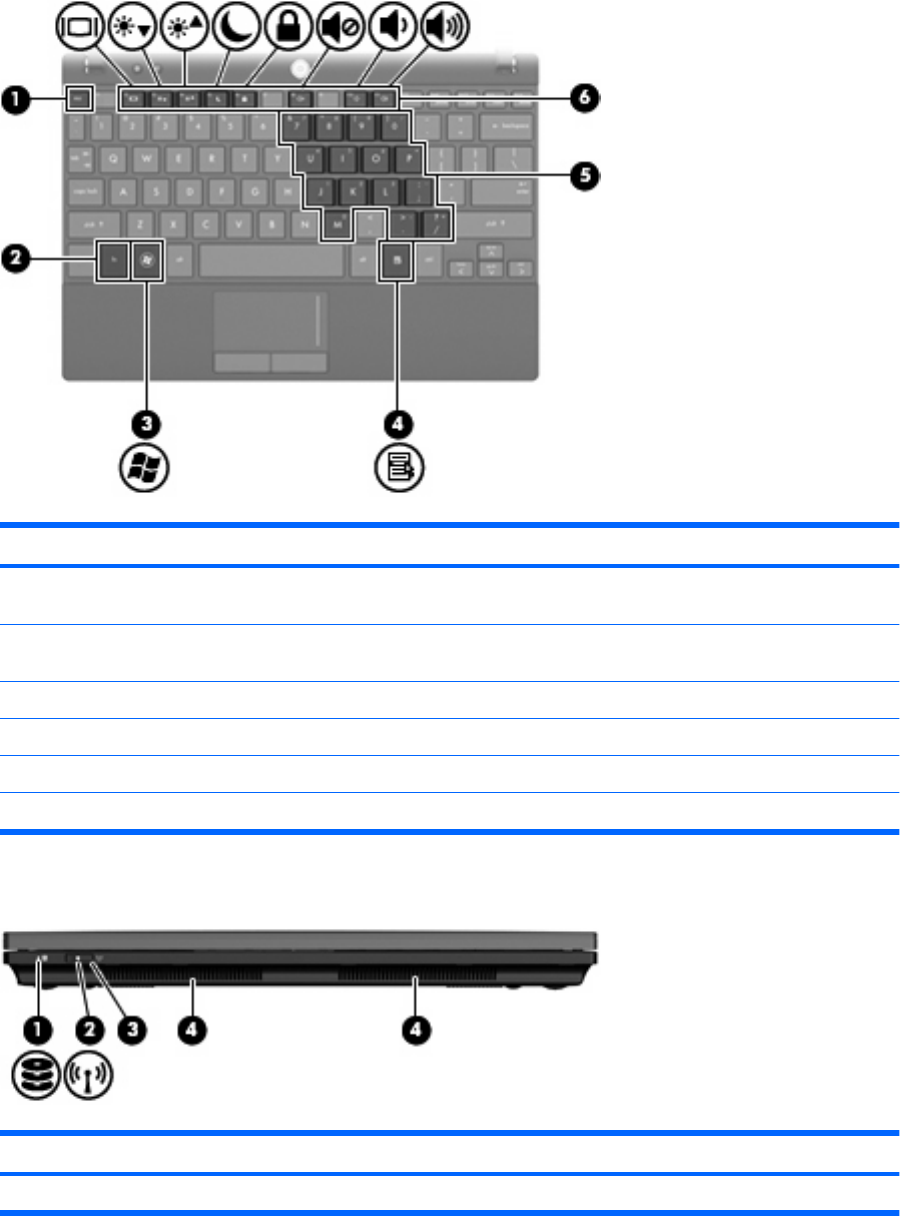
Keys
Component Description
(1) esc key Displays system information when pressed in combination with the
fn key.
(2) fn key Displays system information when pressed in combination with the
esc key.
(3) Windows logo key Displays the Windows Start menu.
(4) Windows applications key Displays a shortcut menu for items beneath the pointer.
(5) Embedded numeric keypad keys Can be used like the keys on an external numeric keypad.
(6) Function keys Execute the action represented by the icon on the key.
Front components
Component Description
(1) Drive light Blinking: The hard drive is being accessed.
Identifying the hardware 5
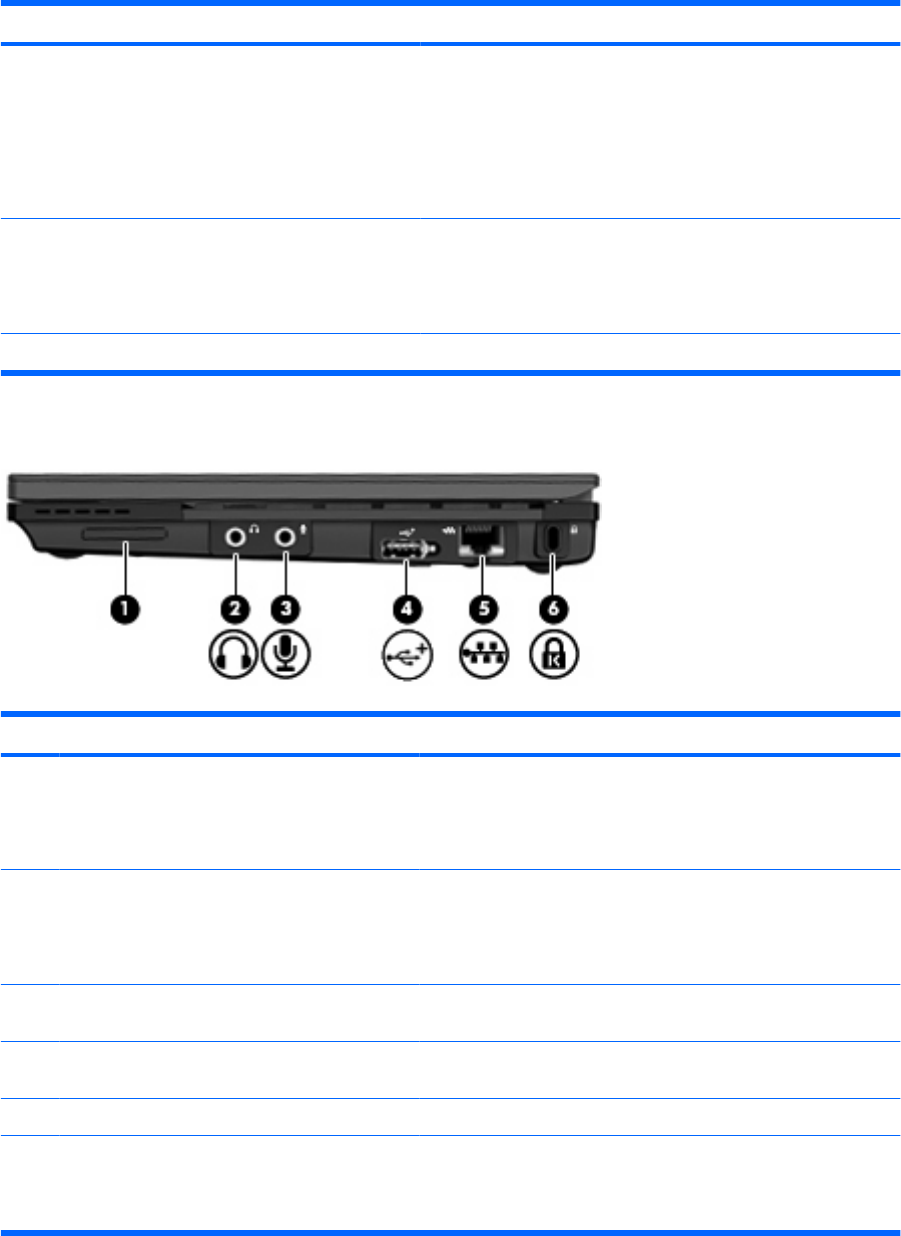
Component Description
(2) Wireless light ●Blue: An integrated wireless device, such as a wireless local
area network (WLAN) device and/or a Bluetooth® device, is
on.
●Amber: All wireless devices are off.
NOTE: The wireless light turns amber when the computer turns
on and all wireless devices are off.
(3) Wireless switch Turns the wireless feature on or off, but does not create a wireless
connection.
NOTE: To establish a wireless connection, a wireless network
must already be set up.
(4) Speakers (2) Produce sound.
Right-side components
Component Description
(1) SD Card Reader Supports the following optional digital card formats:
●MultiMediaCard (MMC)
●Secure Digital (SD) Memory Card
(2) Audio-out (headphone) jack Produces sound when connected to optional powered stereo
speakers, headphones, ear buds, a headset, or television audio.
NOTE: When a device is connected to the headphone jack, the
computer speakers are disabled.
(3) Audio-in (microphone) jack Connects an optional computer headset microphone, stereo array
microphone, or monaural microphone.
(4) Powered USB port Provides power to a USB device, such as an optional external
optical drive, if used with a powered USB cable.
(5) RJ-45 (network) jack Connects a network cable.
(6) Security cable slot Attaches an optional security cable to the computer.
NOTE: The security cable is designed to act as a deterrent, but
it may not prevent the computer from being mishandled or stolen.
6 Chapter 1 Features
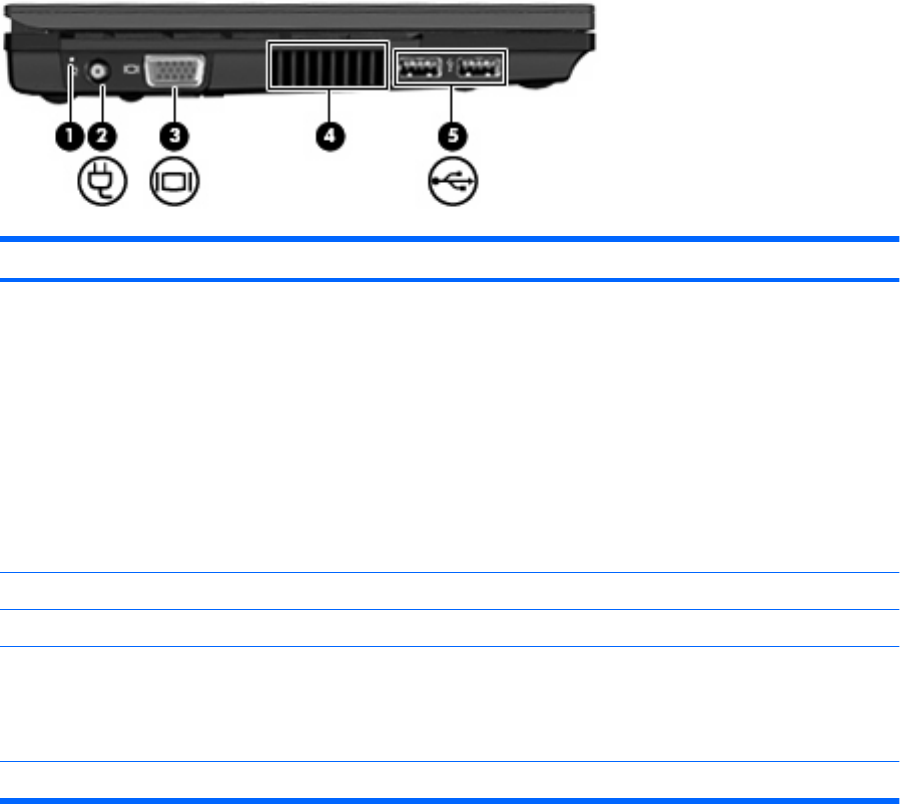
Left-side components
Component Description
(1) Battery light ●Amber: A battery is charging.
●Blue: A battery is close to full charge capacity.
●Blinking amber: A battery that is the only available power
source has reached a low battery level. When the battery
reaches a critical battery level, the battery light begins blinking
rapidly.
●Off: If the computer is plugged into an external power source,
the light turns off when all batteries in the computer are fully
charged. If the computer is not plugged into an external power
source, the light stays off until the battery reaches a low
battery level.
(2) Power connector Connects an AC adapter.
(3) External monitor port Connects an external VGA monitor or projector.
(4) Vent Enables airflow to cool internal components.
NOTE: The computer fan starts up automatically to cool internal
components and prevent overheating. It is normal for the internal
fan to cycle on and off during routine operation.
(5) USB ports (2) Connect optional USB devices.
Identifying the hardware 7
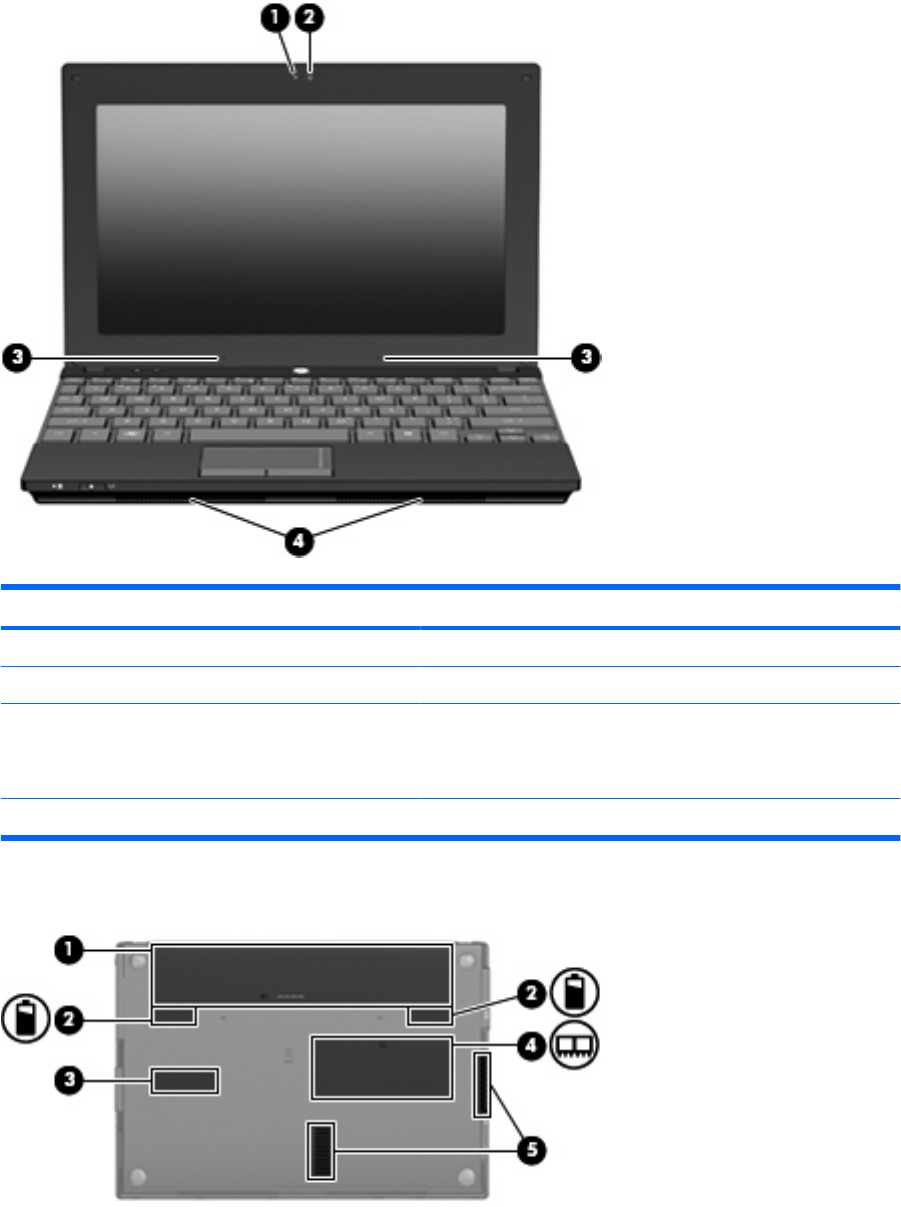
Display components
Component Description
(1) Webcam light On: The webcam is in use.
(2) Webcam Records audio and video and captures still photographs.
(3) Internal microphones (2) Record sound.
NOTE: If there is a microphone icon next to each microphone
opening, your computer has internal microphones.
(4) Speakers (2) Produce sound.
Bottom components
8 Chapter 1 Features
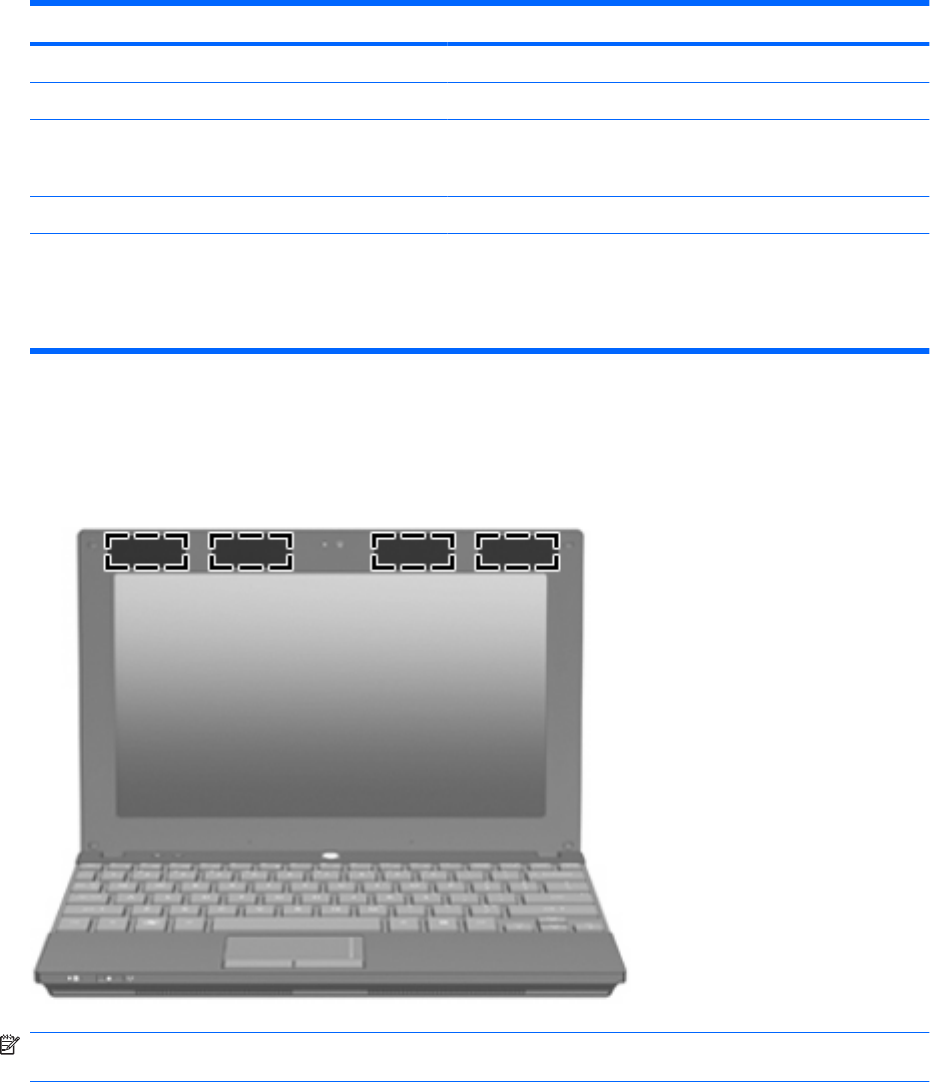
Component Description
(1) Battery bay Holds the battery.
(2) Battery release latches (2) Release the battery from the battery bay.
(3) Service tag Provides the product brand and series name, serial number (s/n),
and product number (p/n) of your computer. Have this information
available when you contact technical support.
(4) Memory module compartment Contains the memory module slot.
(5) Vents (2) Enable airflow to cool internal components.
NOTE: The computer fan starts up automatically to cool internal
components and prevent overheating. It is normal for the internal
fan to cycle on and off during routine operation.
Wireless antennas
On select computer models, at least 2 antennas send and receive signals from one or more wireless
devices. These antennas are not visible from the outside of the computer.
NOTE: For optimal transmission, keep the areas immediately around the WLAN and WWAN antennas
free from obstructions.
To see wireless regulatory notices, refer to the section of the Regulatory, Safety and Environmental
Notices that applies to your country or region. These notices are located in Help and Support.
Identifying the hardware 9
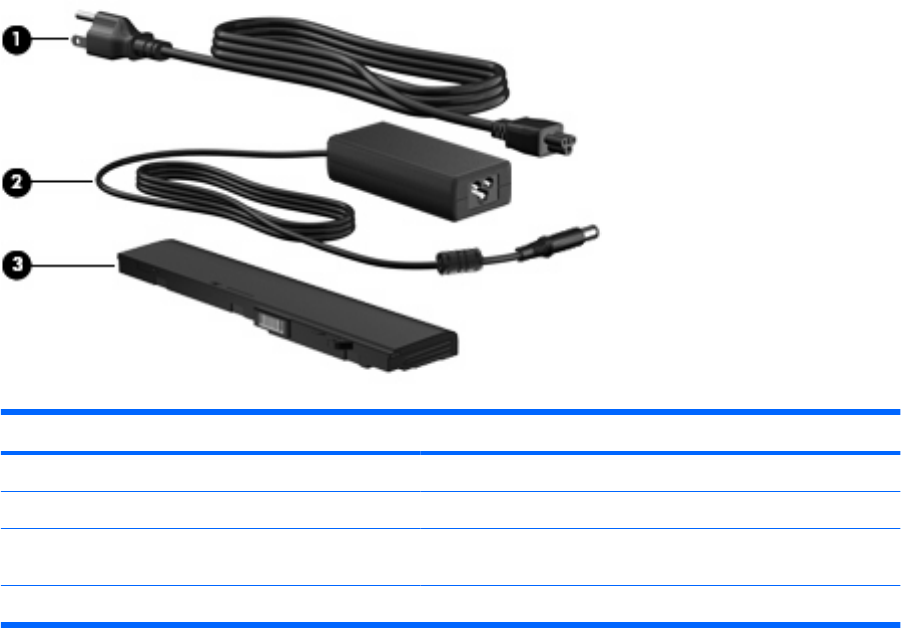
Additional hardware components
Component Description
(1) Power cord* Connects an AC adapter to an AC outlet.
(2) AC adapter Converts AC power to DC power.
(3) Battery* Powers the computer when the computer is not plugged into
external power.
*Batteries and power cords vary in appearance by region and country.
Identifying the labels
The labels affixed to the computer provide information you may need when you troubleshoot system
problems or travel internationally with the computer.
●Service tag—Provides important information including:
10 Chapter 1 Features

◦Product Name (1). This is the product name affixed to the front of your computer.
◦Serial Number (s/n) (2). This is an alphanumeric identifier that is unique to each product.
◦Part Number/Product Number (p/n) (3). This number provides specific information about the
product's hardware components. The part number helps a service technician to determine
what components and parts are needed.
◦Model Description (4). This is the alphanumeric identifier you need to locate documents,
drivers, and support for your computer.
◦Warranty period (5). This number describes the duration (in years) of the warranty period for
this computer.
Have this information available when you contact technical support. The service tag label is affixed
to the bottom of the computer.
●Microsoft® Certificate of Authenticity—Contains the Windows Product Key. You may need the
Product Key to update or troubleshoot the operating system. This certificate is affixed to the bottom
of the computer.
●Regulatory label—Provides regulatory information about the computer. The regulatory label is
affixed to the bottom of the computer.
●Wireless certification label(s) (select models only)—Provide information about optional wireless
devices and the approval markings of some of the countries or regions in which the devices have
been approved for use. An optional device may be a wireless local area network (WLAN) device
or an optional Bluetooth® device. If your computer model includes one or more wireless devices,
one or more certification labels are included with your computer. You may need this information
when traveling internationally. Wireless certification labels are affixed inside the battery bay.
Identifying the labels 11

2 Power management
Setting power options
Using power-saving states
The computer has two power-saving states enabled at the factory: Standby and Hibernation.
When Standby is initiated, the power lights blink and the screen clears. Your work is saved to memory.
Exiting Standby is faster than exiting Hibernation. If the computer is in Standby for an extended period
or if the battery reaches a critical battery level while in Standby, the computer initiates Hibernation.
When Hibernation is initiated, your work is saved to a hibernation file on the hard drive and the computer
turns off.
CAUTION: To prevent possible audio and video degradation, loss of audio or video playback
functionality, or loss of information, do not initiate Standby or Hibernation while reading from or writing
to a disc or an external media card.
NOTE: You cannot initiate any type of networking connection or perform any computer functions while
the computer is in Standby or in Hibernation.
NOTE: When HP 3D DriveGuard has parked a drive, the computer will not initiate Standby or
Hibernation, and the display will be turned off.
Initiating and exiting Standby
The system is set at the factory to initiate Standby after 10 minutes of inactivity when running on battery
power and 25 minutes of inactivity when running on external power.
Power settings and timeouts can be changed using Power Options in Windows® Control Panel.
With the computer on, you can initiate Standby in any of the following ways:
●Press f5.
●Click Start > Turn Off Computer > Stand By.
If Stand by is not displayed, follow these steps:
a. Click the down arrow.
b. Select Stand by from the list.
c. Click OK.
12 Chapter 2 Power management

To exit Standby:
▲Briefly press the power button.
When the computer exits Standby, the power lights turn on and your work returns to the screen
where you stopped working.
NOTE: If you have set a password to be required when the computer exits Standby, you must enter
your Windows password before your work will return to the screen.
Initiating and exiting Hibernation
The system is set at the factory to initiate Hibernation after 30 minutes of inactivity when running on
battery power or when the battery reaches a critical battery level.
NOTE: The system will not initiate Hibernation when running on external power.
Power settings and timeouts can be changed using Power Options in Windows Control Panel.
To initiate Hibernation:
1. Select Start > Turn Off Computer.
2. Hold down the shift key and select Hibernate.
If Hibernate is not displayed, follow these steps:
a. Click the down arrow.
b. Select Hibernate from the list.
c. Click OK.
To exit Hibernation:
▲Briefly press the power button.
The power lights turn on and your work returns to the screen where you stopped working.
NOTE: If you have set a password to be required when the computer exits Hibernation, you must enter
your Windows password before your work will return to the screen.
Using the Power Meter
The Power Meter is located in the notification area, at the far right of the taskbar. The Power Meter
allows you to quickly access power settings and view the remaining battery charge.
●To access Power Options, right-click the Power Meter icon and select Adjust Power
Properties.
●To display the percentage of remaining battery charge, double-click the Power Meter icon.
Different battery meter icons indicate whether the computer is running on battery or external power.
To remove the Power Meter icon from the notification area, follow these steps:
1. Right-click the Power Meter icon in the notification area, and then click Adjust Power
Properties.
2. Click the Advanced tab.
Setting power options 13

3. Clear the Always show icon on the taskbar check box.
4. Click Apply, and then click OK.
To show the Power Meter icon in the notification area, follow these steps:
1. Select Start > Control Panel > Performance and Maintenance > Power Options.
2. Click the Advanced tab.
3. Select the Always show icon on the taskbar check box.
4. Click Apply, and then click OK.
NOTE: If you cannot see an icon you have placed in the notification area, click the Show Hidden
Icons icon (< or <<) in the notification area.
Using power schemes
A power scheme is a collection of system settings that manages how the computer uses power. Power
schemes can help you conserve power and maximize computer performance.
The following power schemes are available:
●Portable/Laptop (recommended)
●Home/Office Desk
●Presentation
●Always On
●Minimal Power Management
●Max Battery
You can change the settings of these power plans through Power Options.
Viewing the current scheme
▲Click the Power Meter icon in the notification area, at the far right of the taskbar.
– or –
Select Start > Control Panel > Performance and Maintenance > Power Options.
Selecting a different power scheme
▲Click the Power Meter icon in the notification area, at the far right of the taskbar, and then select
a power scheme from the list.
– or –
a. Select Start > Control Panel > Performance and Maintenance > Power Options.
b. Select a power scheme from the Power schemes list.
c. Click OK.
14 Chapter 2 Power management

Customizing power schemes
1. Select Start > Control Panel > Performance and Maintenance > Power Options.
2. Select a power scheme from the Power schemes list.
3. Modify the Plugged in and Running on batteries settings as needed.
4. Click OK.
Setting password protection upon exiting Standby
To set the computer to prompt for a password when the computer exits Standby, follow these steps:
1. Right-click the Power Meter icon in the notification area, and then click Adjust Power
Properties.
2. Click the Advanced tab.
3. Select the Prompt for password when computer resumes from standby check box.
4. Click Apply.
Using external AC power
External AC power is supplied through one of the following devices:
WARNING! To reduce potential safety issues, use only the AC adapter provided with the computer,
a replacement AC adapter provided by HP, or a compatible AC adapter purchased from HP.
●Approved AC adapter
●Optional docking device or optional expansion product
Connect the computer to external AC power under any of the following conditions:
WARNING! Do not charge the computer battery while you are onboard aircraft.
●When you are charging or calibrating a battery
●When you are installing or modifying system software
●When you are writing information to a CD or DVD
When you connect the computer to external AC power, the following events occur:
●The battery begins to charge.
●If the computer is turned on, the battery meter icon in the notification area changes appearance.
When you disconnect external AC power, the following events occur:
●The computer switches to battery power.
●The display brightness is automatically decreased to save battery life. To increase display
brightness, press the f4 key or reconnect the AC adapter.
Using external AC power 15
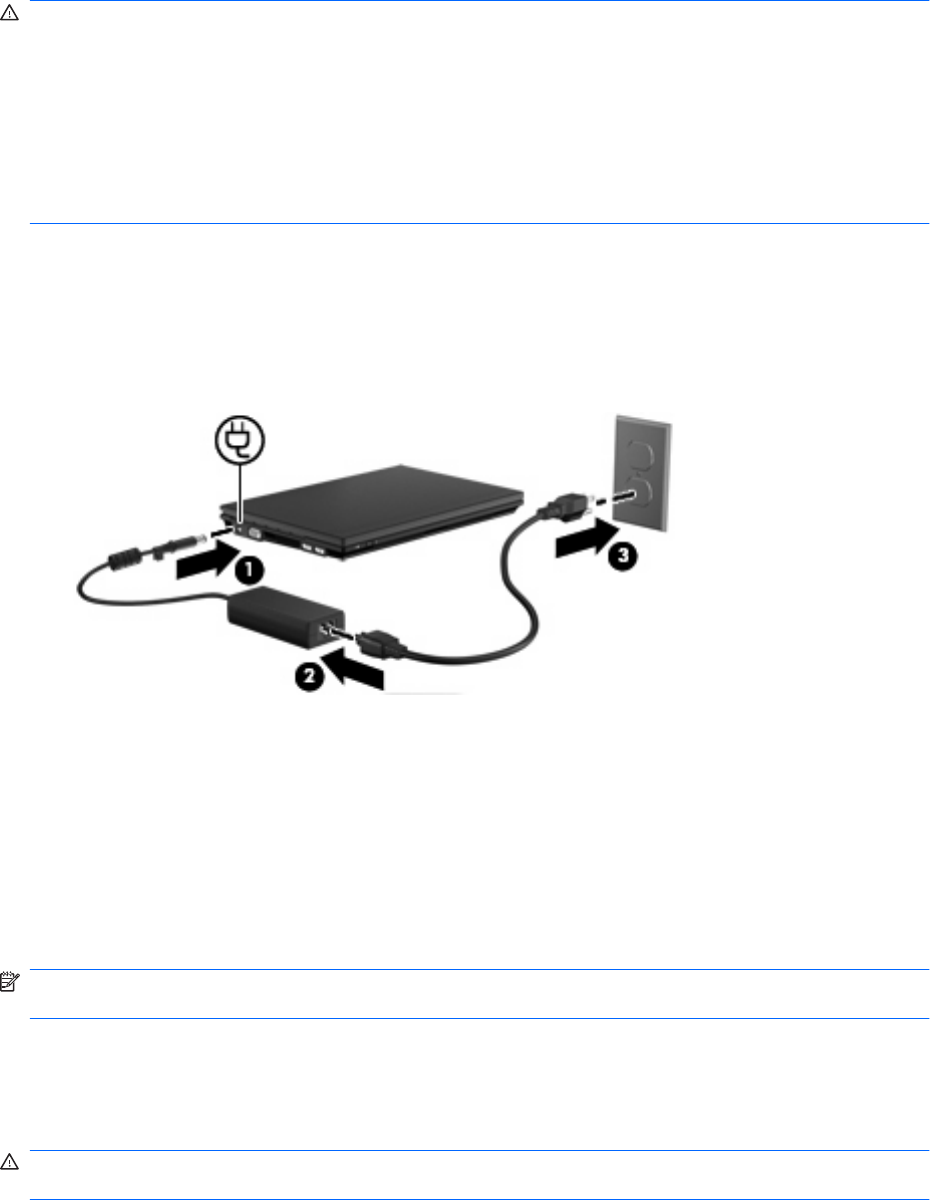
Connecting the AC adapter
WARNING! To reduce the risk of electric shock or damage to the equipment:
Plug the power cord into an AC outlet that is easily accessible at all times.
Disconnect power from the computer by unplugging the power cord from the AC outlet (not by
unplugging the power cord from the computer).
If provided with a 3-pin attachment plug on the power cord, plug the cord into a grounded (earthed) 3-
pin outlet. Do not disable the power cord grounding pin, for example, by attaching a 2-pin adapter. The
grounding pin is an important safety feature.
To connect the computer to external AC power, follow these steps:
1. Plug the AC adapter into the power connector (1) on the computer.
2. Plug the power cord into the AC adapter (2).
3. Plug the other end of the power cord into an AC outlet (3).
Using battery power
When a charged battery is in the computer and the computer is not plugged into external power, the
computer runs on battery power. When the computer is plugged into external AC power, the computer
runs on AC power.
If the computer contains a charged battery and is running on external AC power supplied through the
AC adapter, the computer switches to battery power if the AC adapter is disconnected from the
computer.
NOTE: The display brightness is decreased to save battery life when you disconnect AC power. To
increase display brightness, use the f4 key or reconnect the AC adapter.
You can keep a battery in the computer or in storage, depending on how you work. Keeping the battery
in the computer whenever the computer is plugged into AC power charges the battery and also protects
your work in case of a power outage. However, a battery in the computer slowly discharges when the
computer is off and unplugged from external power.
WARNING! To reduce potential safety issues, use only the battery provided with the computer, a
replacement battery provided by HP, or a compatible battery purchased from HP.
Computer battery life varies, depending on power management settings, programs running on the
computer, display brightness, external devices connected to the computer, and other factors.
16 Chapter 2 Power management
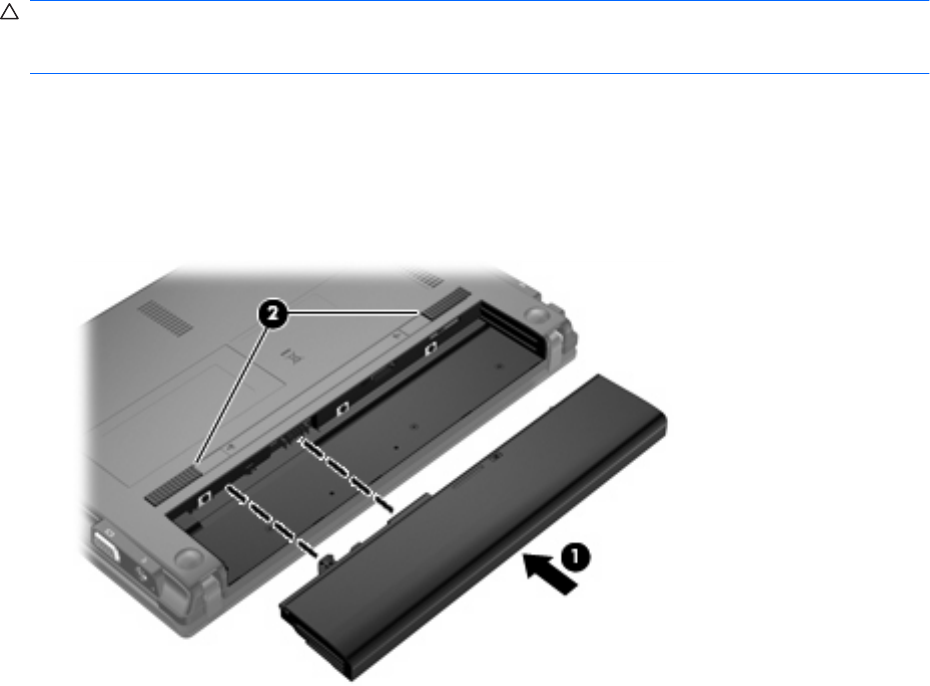
Displaying the remaining battery charge
▲Double-click the Power Meter icon in the notification area, at the far right of the taskbar.
– or –
Select Start > Control Panel > Performance and Maintenance > Power Options > Power
Meter tab.
Most charge indicators report battery status as both a percentage and as the number of minutes of
charge remaining:
●The percentage indicates the approximate amount of charge remaining in the battery.
●The time indicates the approximate running time remaining on the battery if the battery continues
to provide power at the current level. For example, the time remaining will decrease when a DVD
is playing and will increase when a DVD stops playing.
When a battery is charging, a lightning bolt icon may be superimposed over the battery icon on the
Power Meter screen.
Inserting or removing the battery
CAUTION: Removing a battery that is the sole power source can cause loss of information. To prevent
loss of information, initiate Hibernation or shut down the computer through Windows before removing
the battery.
To insert the battery:
1. Turn the computer upside down on a flat surface, with the battery bay toward you.
2. Insert the battery into the battery bay (1) and push in until it is seated.
The battery release latches (2) automatically lock the battery into place.
Using battery power 17
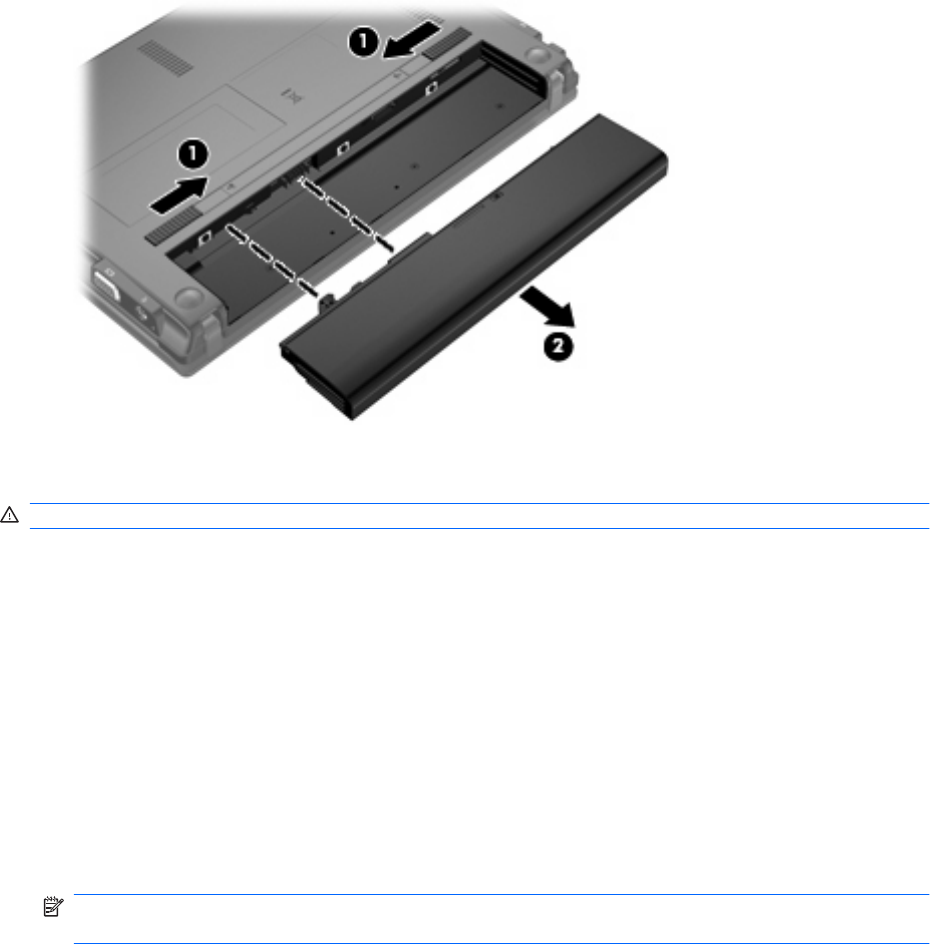
To remove the battery:
1. Turn the computer upside down on a flat surface, with the battery bay toward you.
2. Slide the battery release latches (1) to release the battery.
3. Remove the battery (2) from the computer.
Charging a battery
WARNING! Do not charge the computer battery while you are onboard aircraft.
The battery charges whenever the computer is plugged into external power through an AC adapter, an
optional power adapter, an optional expansion product, or an optional docking device.
The battery charges whether the computer is off or in use, but it charges faster when the computer is
off.
Charging may take longer if a battery is new, has been unused for 2 weeks or more, or is much warmer
or cooler than room temperature.
To prolong battery life and optimize the accuracy of battery charge displays, follow these
recommendations:
●If you are charging a new battery, charge it fully before turning on the computer.
●Charge the battery until the battery light turns off.
NOTE: If the computer is on while the battery is charging, the battery meter in the notification
area may show 100 percent charge before the battery is fully charged.
●Allow the battery to discharge below 5 percent of a full charge through normal use before charging
it.
●If the battery has been unused for one month or more, calibrate the battery instead of simply
charging it.
18 Chapter 2 Power management
The battery light displays charge status:
●On: The battery is charging.
●Blinking: The battery has reached a low battery level or critical battery level and is not charging.
●Off: The battery is fully charged, in use, or not installed.
Maximizing battery discharge time
Battery discharge time varies, depending on the features you use while on battery power. Maximum
discharge time gradually shortens as the battery storage capacity naturally degrades.
Tips for maximizing battery discharge time:
●Lower the brightness on the display.
●Remove the battery from the computer when it is not being used or charged.
●Store the battery in a cool, dry location.
Managing low battery levels
The information in this section describes the alerts and system responses set at the factory. Some low-
battery alerts and system responses can be changed using Power Options in Windows Control Panel.
Preferences set using Power Options do not affect lights.
Identifying low battery levels
When a battery that is the sole power source for the computer reaches a low battery level, the battery
light blinks.
If a low battery level is not resolved, the computer enters a critical battery level, and the battery light
blinks rapidly.
The computer takes the following actions for a critical battery level:
●If Hibernation is enabled and the computer is on or in Standby, the computer initiates Hibernation.
●If Hibernation is disabled and the computer is on or in Standby, the computer remains briefly in
Standby, and then shuts down and loses any unsaved information.
Using battery power 19

Resolving a low battery level
CAUTION: To reduce the risk of losing information when the computer reaches a critical battery level
and has initiated Hibernation, do not restore power until the power lights turn off.
Resolving a low battery level when external power is available
▲Connect one of the following devices:
●AC adapter
●Optional expansion product or docking device
●Optional power adapter
Resolving a low battery level when a charged battery is available
1. Turn off the computer or initiate Hibernation.
2. Remove the discharged battery, and then insert a charged battery.
3. Turn on the computer.
Resolving a low battery level when no power source is available
▲Initiate Hibernation.
– or –
Save your work and shut down the computer.
Resolving a low battery level when the computer cannot exit Hibernation
When the computer lacks sufficient power to exit Hibernation, follow these steps:
1. Insert a charged battery or plug the computer into external power.
2. Exit Hibernation by briefly pressing the power button.
Calibrating a battery
Calibrate a battery under the following conditions:
●When battery charge displays seem inaccurate
●When you observe a significant change in battery run time
Even if a battery is heavily used, it should not need to be calibrated more than once a month. It is also
not necessary to calibrate a new battery.
Step 1: Fully charge the battery
WARNING! Do not charge the computer battery while you are onboard aircraft.
NOTE: The battery charges whether the computer is off or in use, but it charges faster when the
computer is off.
20 Chapter 2 Power management
To fully charge the battery:
1. Insert the battery into the computer.
2. Connect the computer to an AC adapter, optional power adapter, optional expansion product, or
optional docking device, and then plug the adapter or device into external power.
The battery light on the computer turns on.
3. Leave the computer plugged into external power until the battery is fully charged.
The battery light on the computer turns off.
Step 2: Disable Hibernation and Standby
1. Right-click the Power Meter icon in the notification area, at the far right of the taskbar, and then
click Adjust Power Properties.
– or –
Select Start > Control Panel > Performance and Maintenance > Power Options.
2. Record the 4 settings listed in the Running on batteries and Plugged in columns so that you can
reset them after the calibration.
3. Set the 4 options to Never.
4. Click OK.
Step 3: Discharge the battery
The computer must remain on while the battery is being discharged. The battery can discharge whether
or not you are using the computer, but the battery will discharge faster while you are using it.
●If you plan to leave the computer unattended during the discharge, save your information before
beginning the discharge procedure.
●If you use the computer occasionally during the discharge procedure and have set energy-saving
timeouts, expect the following performance from the system during the discharge process:
◦The monitor will not turn off automatically.
◦Hard drive speed will not decrease automatically when the computer is idle.
◦System-initiated Hibernation will not occur.
To discharge a battery:
1. Unplug the computer from its external power source, but do not turn off the computer.
2. Run the computer on battery power until the battery is discharged. The battery light begins to blink
when the battery has discharged to a low battery level. When the battery is discharged, the battery
light turns off and the computer shuts down.
Using battery power 21

Step 4: Fully recharge the battery
To recharge the battery:
1. Plug the computer into external power and maintain external power until the battery is fully
recharged. When the battery is recharged, the battery light on the computer turns off.
You can use the computer while the battery is recharging, but the battery will charge faster if the
computer is off.
2. If the computer is off, turn it on when the battery is fully charged and the battery light has turned
off.
Step 5: Reenable Hibernation and Standby
CAUTION: Failure to reenable Hibernation after calibration may result in a full battery discharge and
information loss if the computer reaches a critical battery level.
1. Select Start > Control Panel > Performance and Maintenance > Power Options.
2. Reenter the settings that you recorded for the items in the Plugged in column and the Running
on batteries column.
3. Click OK.
Conserving battery power
●Select low power-use settings through Power Options in Windows Control Panel.
●Turn off wireless and local area network (LAN) connections and exit modem applications when you
are not using them.
●Disconnect external devices that are not plugged into an external power source, when you are not
using them.
●Stop, disable, or remove any external media cards that you are not using.
●Use the f3 and f4 keys to adjust screen brightness as needed.
●If you leave your work, initiate Standby or Hibernation, or shut down the computer.
Storing a battery
CAUTION: To prevent damage to a battery, do not expose it to high temperatures for extended periods
of time.
If a computer will be unused and unplugged from external power for more than 2 weeks, remove the
battery and store it separately.
To prolong the charge of a stored battery, place it in a cool, dry place.
NOTE: A stored battery should be checked every 6 months. If the capacity is less than 50 percent,
recharge the battery before returning it to storage.
Calibrate a battery before using it if it has been stored for one month or more.
22 Chapter 2 Power management

Disposing of a used battery
WARNING! To reduce the risk of fire or burns, do not disassemble, crush, or puncture; do not short
external contacts; do not dispose of in fire or water.
Refer to the Regulatory, Safety and Environmental Notices for battery disposal information.
Replacing the battery
Computer battery life varies, depending on the power management settings, programs running on the
computer, display brightness, external devices connected to the computer, and other factors.
NOTE: To ensure that you always have battery power when you need it, HP recommends purchasing
a new battery when the storage capacity indicator turns green-yellow.
Using battery power 23

Testing an AC adapter
Test the AC adapter if the computer exhibits any of the following symptoms:
●The computer will not turn on when connected to the AC adapter.
●The display does not turn on when the computer is connected to the AC adapter.
●The power light is off when the computer is connected to the AC adapter.
To test the AC adapter:
1. Remove the battery from the computer.
2. Connect the AC adapter.
3. Turn on the computer.
●If the power light turns on, the AC adapter is functioning properly.
●If the power light remains off, the AC adapter is not functioning and should be replaced.
Contact technical support for information on obtaining a replacement AC power adapter by
selecting Start > Help and Support.
Shutting down the computer
CAUTION: Unsaved information will be lost when the computer is shut down.
The Shut Down command closes all open programs, including the operating system, and then turns off
the display and computer.
Shut down the computer under any of the following conditions:
●When you need to replace the battery or access components inside the computer
●When you are connecting an external hardware device that does not connect to a USB port
●When the computer will be unused and disconnected from external power for an extended period
To shut down the computer, follow these steps:
NOTE: If the computer is in Standby or in Hibernation, you must first exit Standby or Hibernation before
shutdown is possible.
1. Save your work and close all open programs.
2. Select Start > Turn Off Computer > Turn Off.
If the computer is unresponsive and you are unable to use the preceding shutdown procedures, try the
following emergency procedures in the sequence provided:
●Press ctrl+alt+delete. Then, select Shut Down > Turn Off.
●Press and hold the power button for at least 5 seconds.
●Disconnect the computer from external power and remove the battery.
24 Chapter 2 Power management

3Wireless
Using wireless devices (select models only)
Wireless technology transfers data across radio waves instead of wires. Your computer may be
equipped with one or more of the following wireless devices:
●Wireless local area network (WLAN) device—Connects the computer to wireless local area
networks (commonly referred to as Wi-Fi networks, wireless LANs, or WLANs) in corporate offices,
your home, and public places such as airports, restaurants, coffee shops, hotels, and universities.
In a WLAN, each mobile wireless device communicates with a wireless router or a wireless access
point.
●Bluetooth® device—Creates a personal area network (PAN) to connect to other Bluetooth-enabled
devices such as computers, phones, printers, headsets, speakers, and cameras. In a PAN, each
device communicates directly with other devices, and devices must be relatively close together—
typically within 10 meters (approximately 33 feet) of each other.
Computers with WLAN devices support one or more of the following IEEE industry standards:
●802.11b, the first popular standard, supports data rates of up to 11 Mbps and operates at a
frequency of 2.4 GHz.
●802.11g supports data rates of up to 54 Mbps and operates at a frequency of 2.4 GHz. An 802.11g
WLAN device is backward compatible with 802.11b devices, so they can operate on the same
network.
●802.11a supports data rates of up to 54 Mbps and operates at a frequency of 5 GHz.
NOTE: 802.11a is not compatible with 802.11b and 802.11g.
●Wi-Fi CERTIFIED 802.11n draft 2.0 supports data rates of up to 300 Mbps and may operate at 2.4
GHz or 5 GHz, making it backward compatible with 802.11a, b, and g.
NOTE: The specifications for the 802.11n WLAN are draft specifications and are not final. If the
final specifications differ from the draft specifications, it may affect the ability of the computer to
communicate with other 802.11n WLAN devices.
For more information on wireless technology, refer to the information and Web site links provided in
Help and Support.
Identifying wireless and network icons
Icon Name Description
Using wireless devices (select models only) 25

Wireless (connected) Identifies the location of the wireless lights and the wireless switch on
the computer.
Wireless
(disconnected)
Indicates that all of the wireless devices are off.
Network status
(connected)
Indicates that one or more of your network drivers are installed and one
or more network devices are connected to the network.
Network status
(disconnected)
Indicates that one or more of your network drivers are installed but no
network devices are connected to the network.
Using the wireless controls
You can control the wireless devices in your computer using these features:
●Wireless switch
●Operating system controls
Using the wireless switch
The computer has a wireless switch, one or more wireless devices, and one or two wireless lights,
depending on the model. All of the wireless devices on your computer are enabled at the factory, so the
wireless light is on (blue) when you turn on the computer.
The wireless light indicates the overall power state of your wireless devices, not the status of individual
devices. If the wireless light is blue, at least one wireless device is on. If the wireless light is amber, all
wireless devices are off.
Because the wireless devices are enabled at the factory, you can use the wireless switch to turn on or
turn off the wireless devices simultaneously. Individual wireless devices can be controlled through
Computer Setup.
NOTE: If the wireless devices are disabled by Computer Setup, the wireless switch will not work until
you reenable your devices.
Using operating system controls
Some operating systems also offer a way to manage integrated wireless devices and the wireless
connection. For more information, refer to the operating system documentation.
26 Chapter 3 Wireless
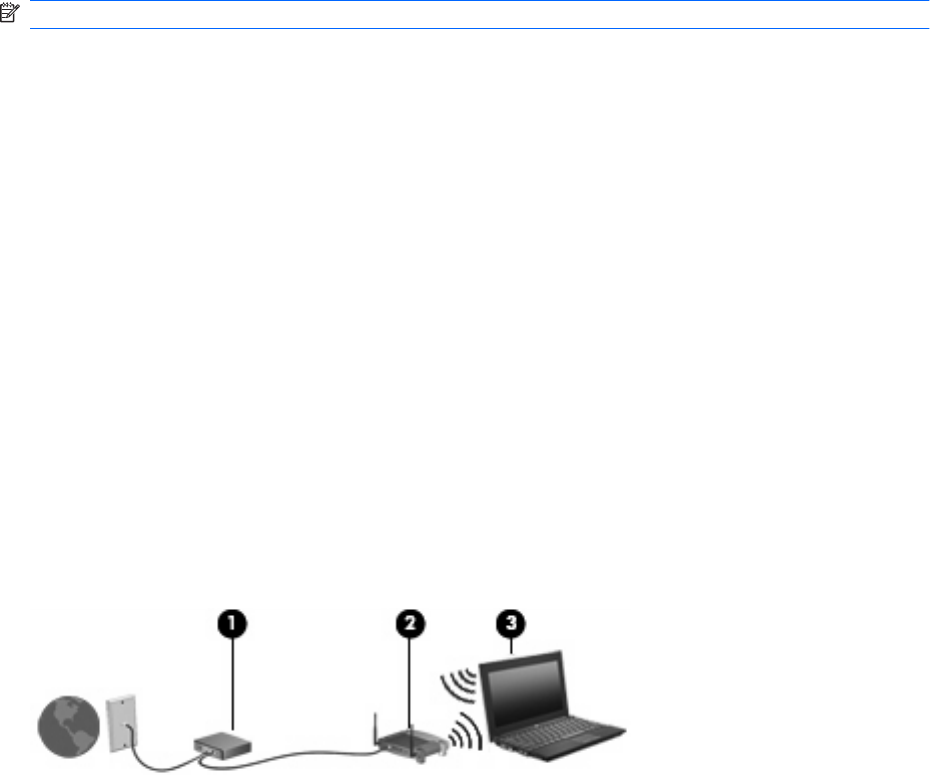
Using a WLAN
With a WLAN device, you can access a wireless local area network (WLAN), which is composed of other
computers and accessories that are linked by a wireless router or a wireless access point.
NOTE: The terms wireless router and wireless access point are often used interchangeably.
●A large-scale WLAN, such as a corporate or public WLAN, typically uses wireless access points
that can accommodate a large number of computers and accessories and can separate critical
network functions.
●A home or small office WLAN typically uses a wireless router, which allows several wireless and
wired computers to share an Internet connection, a printer, and files without requiring additional
pieces of hardware or software.
To use the WLAN device in your computer, you must connect to a WLAN infrastructure (provided through
a service provider or a public or corporate network).
Setting up a WLAN
To set up a WLAN and connect to the Internet, you need the following equipment:
●A broadband modem (either DSL or cable) (1) and high-speed Internet service purchased from an
Internet service provider (ISP)
●A wireless router (purchased separately) (2)
●The wireless computer (3)
The illustration below shows an example of a wireless network installation that is connected to the
Internet.
As your network grows, additional wireless and wired computers can be connected to the network to
access the Internet.
For help in setting up your WLAN, refer to the information provided by your router manufacturer or your
ISP.
Protecting your WLAN
Because the WLAN standard was designed with only limited security capabilities—basically to foil casual
eavesdropping rather than more powerful forms of attack—it is essential to understand that WLANs are
vulnerable to well-known and well-documented security weaknesses.
WLANs in public areas, or “hotspots,” like coffee shops and airports may not provide any security. New
technologies are being developed by wireless manufacturers and hotspot service providers that make
the public environment more secure and anonymous. If you are concerned about the security of your
computer in a hotspot, limit your network activities to noncritical e-mail and basic Internet surfing.
Using a WLAN 27

When you set up a WLAN or access an existing WLAN, always enable security features to protect your
network from unauthorized access. The common security levels are Wi-Fi Protected Access (WPA) and
Wired Equivalent Privacy (WEP). Because wireless radio signals travel outside the network, other WLAN
devices can pick up unprotected signals and either connect to your network (uninvited) or capture
information being sent across it. However, you can take precautions to protect your WLAN:
●Use a wireless transmitter with built-in security
Many wireless base stations, gateways, and routers provide built-in security features such as
wireless security protocols and firewalls. With the correct wireless transmitter, you can protect your
network from the most common wireless security risks.
●Work behind a firewall
A firewall is a barrier that checks both data and requests for data that are sent to your network and
then discards any suspicious items. Firewalls are available in many varieties, both software and
hardware. Some networks use a combination of both types.
●Use wireless encryption
A variety of sophisticated encryption protocols is available for your WLAN. Find the solution that
works best for your network security:
◦Wired Equivalent Privacy (WEP) is a wireless security protocol that uses a WEP key to
encode or encrypt all network data before it is transmitted. Usually, you can allow the network
to assign the WEP key. Alternatively, you can set up your own key, generate a different key,
or choose other advanced options. Without the correct key, others will not be able to use the
WLAN.
◦WPA (Wi-Fi Protected Access), like WEP, uses security settings to encrypt and decrypt data
that is transmitted over the network. However, instead of using one static security key for
encryptions as WEP does, WPA uses temporal key integrity protocol (TKIP) to dynamically
generate a new key for every packet. It also generates different sets of keys for each computer
on the network.
●Close your network
If possible, prevent your network name (SSID) from being broadcast by the wireless transmitter.
Most networks initially broadcast the name, telling any computer nearby that your network is
available. By closing the network, other computers are less likely to know that your network exists.
NOTE: If your network is closed and the SSID is not broadcast, you will need to know or remember
the SSID to connect new devices to the network. Write down the SSID and store it in a secure
place before closing the network.
28 Chapter 3 Wireless

Connecting to a WLAN
To connect to the WLAN, follow these steps:
1. Be sure that the WLAN device is on. If it is on, the wireless light is on. If the wireless light is amber,
slide the wireless switch.
2. Select Start > Connect To.
3. Select your WLAN from the list, and then type the network security key, if required.
●If the network is unsecured, meaning that anyone can access the network, a warning is
displayed. Click Connect Anyway to accept the warning and complete the connection.
●If the network is a security-enabled WLAN, you are prompted to enter a network security key,
which is a security code. Type the code, and then click Connect to complete the connection.
NOTE: If no WLANs are listed, you are out of range of a wireless router or access point.
NOTE: If you do not see the network you want to connect to, click Show all connections. A list
of options will appear that includes creating a new network connection, as well as troubleshooting
connection issues.
After the connection is made, place the mouse pointer over the network status icon in the notification
area, at the far right of the taskbar, to verify the name and status of the connection.
NOTE: The functional range (how far your wireless signals travel) depends on WLAN implementation,
router manufacturer, and interference from other electronic devices or structural barriers such as walls
and floors.
More information about using a WLAN is available through the following resources:
●Information from your ISP and the manufacturer's instructions included with your wireless router
and other WLAN equipment
●Information and Web site links provided in Help and Support
For a list of public WLANs near you, contact your ISP or search the Web. Web sites that list public
WLANs include Cisco Internet Mobile Office Wireless Locations, Hotspotlist, and Geektools. Check with
each public WLAN location for cost and connection requirements.
For additional information on connecting your computer to a corporate WLAN, contact your network
administrator or IT department.
Roaming to another network
When you move your computer within range of another WLAN, Windows attempts to connect to that
network. If the attempt is successful, your computer is automatically connected to the new network. If
Windows does not recognize the new network, follow the same procedure you used initially to connect
to your WLAN.
Using a WLAN 29

Using HP Mobile Broadband (select models only)
HP Mobile Broadband enables your computer to use wireless wide area networks (WWANs) to access
the Internet from more places and over larger areas than it can by using WLANs. Using HP Mobile
Broadband requires a network service provider (called a mobile network operator), which in most cases
is a mobile phone network operator. Coverage for HP Mobile Broadband is similar to mobile phone voice
coverage.
When used with mobile network operator service, HP Mobile Broadband gives you the freedom to stay
connected to the Internet, send e-mail, or connect to your corporate network whether you are on the
road or outside the range of Wi-Fi hotspots.
HP supports the following technologies:
●HSPA (High Speed Packet Access), which provides access to networks based on the Global
System for Mobile Communications (GSM) telecommunications standard.
●EV-DO (Evolution Data Optimized), which provides access to networks based on the code division
multiple access (CDMA) telecommunications standard.
You may need the HP Mobile Broadband Module serial number to activate mobile broadband service.
The serial number is printed on a label inside the battery bay of your computer.
Some mobile network operators require the use of a subscriber identity module (SIM). A SIM contains
basic information about you, such as a PIN (personal identification number), as well as network
information. Some computers include a SIM that is preinstalled in the battery bay. If the SIM is not
preinstalled, it may be provided in the HP Mobile Broadband information provided with your computer
or the mobile network operator may provide it separately from the computer.
For information on inserting and removing the SIM, refer to the “Inserting a SIM” and “Removing a SIM”
sections in this chapter.
For information on HP Mobile Broadband and how to activate service with a preferred mobile network
operator, refer to the HP Mobile Broadband information included with your computer. For additional
information, see the HP Web site at http://www.hp.com/go/mobilebroadband (US only).
Inserting a SIM
CAUTION: To prevent damage to the connectors, use minimal force when inserting a SIM.
To insert a SIM:
1. Shut down the computer. If you are not sure whether the computer is off or in Hibernation, turn the
computer on by pressing the power button. Then shut down the computer through the operating
system.
2. Close the display.
3. Disconnect all external devices connected to the computer.
4. Unplug the power cord from the AC outlet.
5. Turn the computer upside down on a flat surface, with the battery bay toward you.
6. Remove the battery.
30 Chapter 3 Wireless
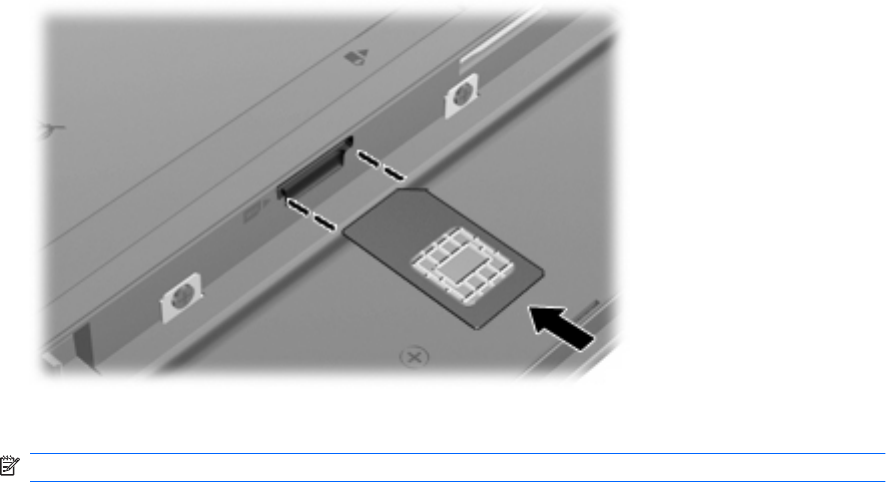
7. Insert the SIM into the SIM slot, and gently push the SIM into the slot until it is firmly seated.
8. Replace the battery.
NOTE: HP Mobile Broadband will be disabled if the battery is not replaced.
9. Reconnect external power.
10. Reconnect external devices.
11. Turn on the computer.
Removing a SIM
To remove a SIM:
1. Shut down the computer. If you are not sure whether the computer is off or in Hibernation, turn the
computer on by pressing the power button. Then shut down the computer through the operating
system.
2. Close the display.
3. Disconnect all external devices connected to the computer.
4. Unplug the power cord from the AC outlet.
5. Turn the computer upside down on a flat surface, with the battery bay toward you.
6. Remove the battery.
Using HP Mobile Broadband (select models only) 31
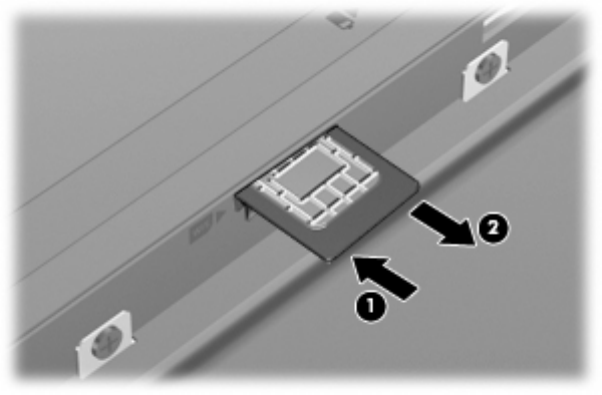
7. Press in on the SIM (1), and then remove it from the slot (2).
8. Replace the battery.
9. Reconnect external power.
10. Reconnect external devices.
11. Turn on the computer.
32 Chapter 3 Wireless
Using Bluetooth wireless devices (select models only)
A Bluetooth device provides short-range wireless communications that replace the physical cable
connections that traditionally link electronic devices such as the following:
●Computers (desktop, notebook, PDA)
●Phones (cellular, cordless, smart phone)
●Imaging devices (printer, camera)
●Audio devices (headset, speakers)
Bluetooth devices provide peer-to-peer capability that allows you to set up a personal area network
(PAN) of Bluetooth devices. For information on configuring and using Bluetooth devices, refer to the
Bluetooth software Help.
Bluetooth and Internet Connection Sharing (ICS)
HP does not recommend setting up one computer with Bluetooth as a host and using it as a gateway
through which other computers may connect to the Internet. When two or more computers are connected
using Bluetooth, and Internet Connection Sharing (ICS) is enabled on one of the computers, the other
computers may not be able to connect to the Internet using the Bluetooth network.
The strength of Bluetooth is in synchronizing information transfers between your computer and wireless
devices including cellular phones, printers, cameras, and PDAs. The inability to consistently connect
two or more computers to share the Internet through Bluetooth is a limitation of Bluetooth and the
Windows operating system.
Using Bluetooth wireless devices (select models only) 33

4 Multimedia
Multimedia features
Your computer includes multimedia features that allow you to listen to music, watch movies, and view
pictures. Your computer may include the following multimedia components:
●Integrated speakers for listening to music
●Integrated microphones for recording your own audio
●Integrated webcam that allows you to capture and share video
●Preinstalled multimedia software that allows you to play and manage your music, movies, and
pictures
●Function keys that provide fast access to volume control
NOTE: Your computer may not include all of the components listed.
The following sections explain how to identify and use the multimedia components included with your
computer.
Identifying your multimedia components
The following illustration and table describe the multimedia features of the computer.
34 Chapter 4 Multimedia
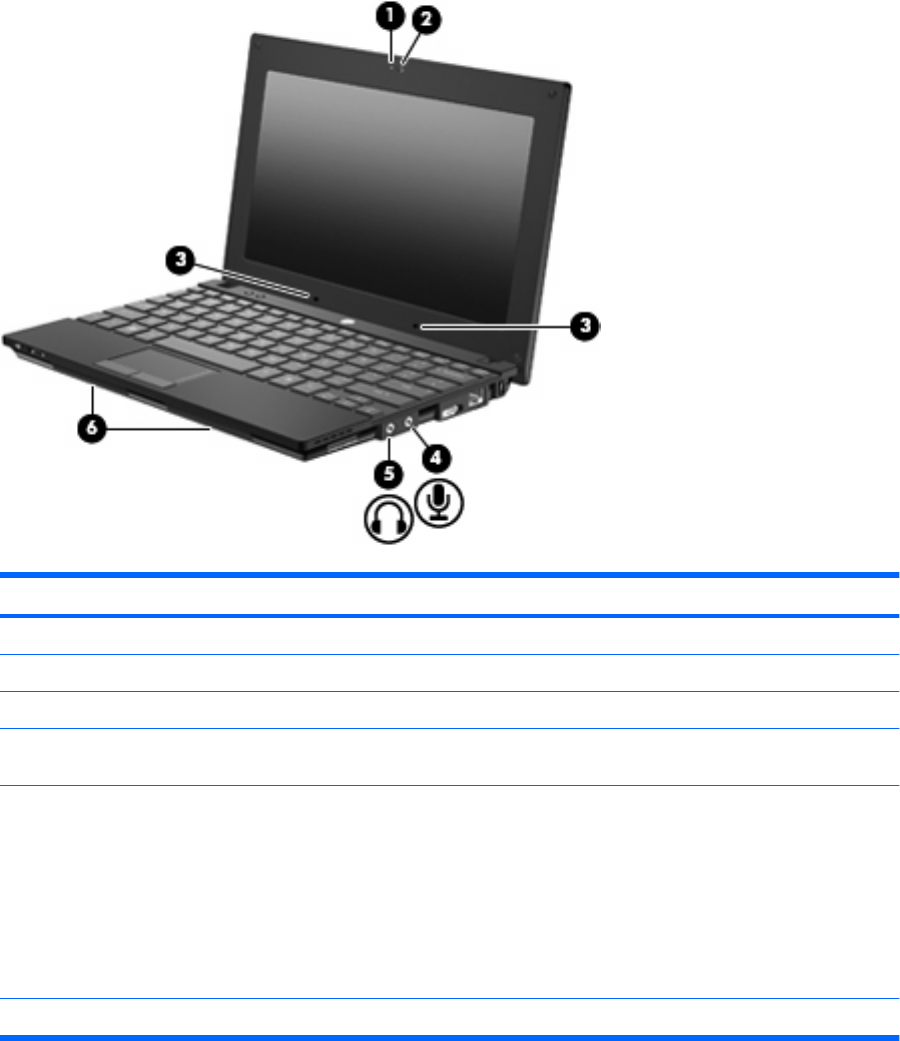
Component Description
(1) Webcam light On: The webcam is in use.
(2) Webcam Records audio and video and captures still photographs.
(3) Internal microphones (2) Record sound.
(4) Audio-in (microphone) jack Connects an optional computer headset microphone, stereo array
microphone, or monaural microphone.
(5) Audio-out (headphone) jack Produces sound when connected to optional powered stereo
speakers, headphones, ear buds, or a headset.
WARNING! To reduce the risk of personal injury, adjust the
volume before putting on headphones, earbuds, or a headset. For
additional safety information, refer to the Regulatory, Safety and
Environmental Notices.
NOTE: When a device is connected to the headphone jack, the
computer speakers are disabled.
(6) Speakers (2) Produce sound.
Adjusting the volume
You can adjust the volume using the following controls:
●Computer volume function keys—Either the f8 (2), f10 (3), or f11 (4) function key:
◦To mute or restore volume, press f8.
◦To decrease volume, press f10.
Multimedia features 35
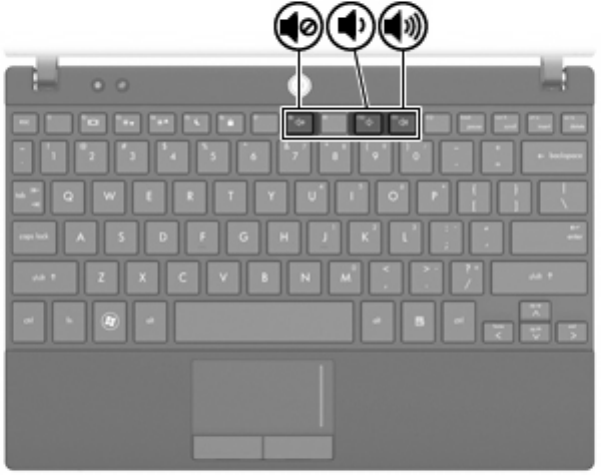
◦To increase volume, press f11.
●Windows® volume control:
a. Click the Volume icon in the notification area, at the far right of the taskbar.
b. Increase or decrease the volume by moving the slider up or down. Select the Mute check box
to mute the volume.
– or –
a. Double-click the Volume icon in the notification area.
b. In the Master Volume column, you can increase or decrease the volume by moving the
Volume slider up or down. You can also adjust the balance or mute the volume.
If the Volume icon is not displayed in the notification area, follow these steps to add it:
a. Select Start > Control Panel > Sounds, Speech, and Audio Devices > Sounds and Audio
Devices > Volume tab.
b. Select the Place volume icon in the taskbar check box.
c. Click Apply.
●Program volume control:
Volume can also be adjusted within some programs.
Multimedia software
Your computer includes preinstalled multimedia software that allows you to play music and view pictures.
The following sections provide details about preinstalled multimedia software and installing multimedia
software from a disc.
36 Chapter 4 Multimedia

Using preinstalled multimedia software
To locate preinstalled multimedia software:
▲Select Start > All Programs, and then open the multimedia program you want to use.
NOTE: Some programs may be located in subfolders.
Installing multimedia software from a disc
NOTE: To install multimedia software from a disc, you must have an external optical drive connected
to the computer. The computer provides one powered USB port on the left side of the computer. This
port provides power to the external optical drive when used with a powered USB cable. An external
optical drive connected to the other USB port on the computer must be connected to AC power.
To install any multimedia software from a CD or DVD, follow these steps:
1. Insert the disc into a connected external optical drive.
2. When the installation wizard opens, follow the on-screen instructions.
3. Restart the computer if prompted to do so.
NOTE: For details about using software included with the computer, refer to the software
manufacturer’s instructions, which may be provided with the software, on disc, or on the
manufacturer’s Web site.
Multimedia software 37

Audio
Your computer enables you to use a variety of audio features:
●Play music using your computer speakers and/or connected external speakers
●Record sound using the internal microphones or connect an external microphone
●Download music from the Internet
●Create multimedia presentations using audio and images
●Transmit sound and images with instant messaging programs
●Stream radio programs (select models only) or receive FM radio signals
●Create or “burn” audio CDs using an external optical drive
Connecting external audio devices
WARNING! To reduce the risk of personal injury, adjust the volume before putting on headphones,
earbuds, or a headset. For additional safety information, refer to the Regulatory, Safety and
Environmental Notices.
To connect external devices such as external speakers, headphone, or a microphone, refer to the
information provided with the device. For best results, remember the following tips:
●Be sure that the device cable is securely connected to the correct jack on your computer. (Cable
connectors are normally color-coded to match the corresponding jacks on the computer.)
●Be sure to install any drivers required by the external device.
NOTE: A driver is a required program that acts like a translator between the device and the
programs that use the device.
Checking your audio functions
To check the system sound on your computer, follow these steps:
1. Select Start > Control Panel.
2. Click Sounds, Speech, and Audio Devices > Sounds and Audio Devices.
3. When the Sounds and Audio Devices Properties window opens, click the Sounds tab. Under
Program events, select any sound event, such as a beep or alarm, and click the Play button.
You should hear sound through the speakers or through connected headphones.
To check the record functions of the computer, follow these steps:
1. Select Start > All Programs > Accessories > Entertainment > Sound Recorder.
2. Click Record and speak into the microphone. Save the file to the desktop.
3. Open Windows Media Player and play back the sound.
38 Chapter 4 Multimedia

NOTE: For best results when recording, speak directly into the microphone and record sound in a
setting free of background noise.
▲To confirm or change the audio settings on your computer, right-click the Sound icon on the
taskbar, or select Start > Control Panel > Sounds, Speech, and Audio Devices > Sounds and
Audio Devices.
Audio 39
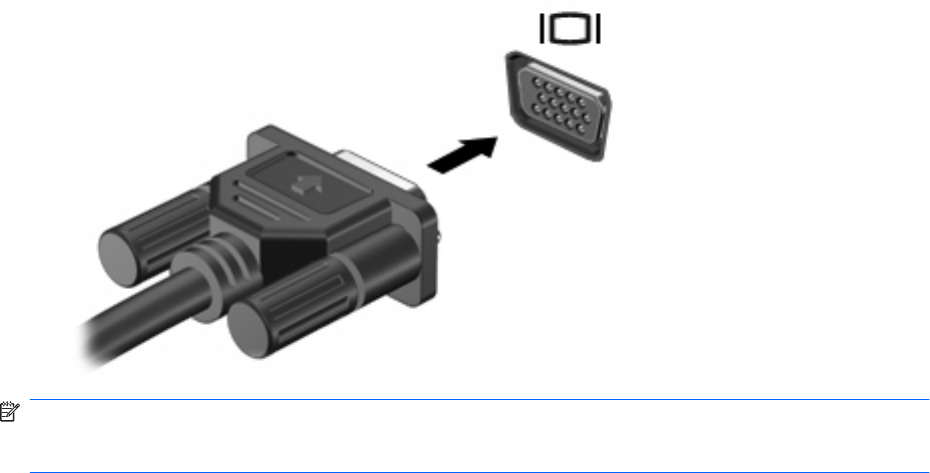
Video
Your computer enables you to use a variety of video features:
●Play games over the Internet
●Edit pictures and video to create presentations
●Connect external video devices
Connecting an external monitor or projector
The external monitor port connects an external display device such as an external monitor or a projector
to the computer.
▲To connect a display device, connect the device cable to the external monitor port.
NOTE: If a properly connected external display device does not display an image, press f2 to transfer
the image to the device. Repeatedly pressing f2 alternates the screen image between the computer
display and the device.
40 Chapter 4 Multimedia

Optical drive (select models only)
Your computer may come with an external optical drive that expands the functionality of the computer.
The external optical drive allows you to read data discs, play music, and watch movies.
Identifying the external optical drive
▲Select Start > My Computer.
You will see a list of all the devices installed on your computer, including the connected external optical
drive. You may have one of the following types of drives:
●DVD-ROM Drive
●DVD/CD-RW Combo Drive
●DVD±RW/R and CD-RW Combo Drive with Double-Layer (DL) support
NOTE: Some of the drives listed above may not be supported by your computer.
Using optical discs
An optical drive, such as a DVD-ROM drive, supports optical discs (CDs and DVDs). These discs store
information, such as music, photos, and movies. DVDs have a higher storage capacity than CDs.
The external optical drive can read standard CD and DVD discs.
NOTE: Some of the optical drives listed may not be supported by your computer. The listed drives are
not necessarily all of the supported optical drives.
Some optical drives can also write to optical discs as described in the following table.
Optical drive type Read from CD and
DVD-ROM media
Write to CD-R/RW
media
Write to DVD (includes
DVD+R DL, DVD±RW/
R, and DVD-ROM
media)
Write label to
LightScribe CD or
DVD
DVD-ROM Drive Yes No No No
DVD/CD-RW Combo
Drive
Yes Yes No No
DVD±RW/CD-RW
Combo Drive
Yes Yes Yes No
CAUTION: To prevent possible audio and video degradation, loss of information, or loss of audio or
video playback functionality, do not initiate Standby or Hibernation while reading or writing to a CD or
DVD.
Selecting the right disc
An optical drive supports optical discs (CDs and DVDs). CDs, used to store digital data, are also used
for commercial audio recordings and are convenient for your personal storage needs. DVDs are used
primarily for movies, software, and data backup purposes. DVDs are the same form factor as CDs but
have 6 to 7 times the storage capacity.
Optical drive (select models only) 41

NOTE: The external optical drive connected to your computer may not support all the types of optical
discs discussed in this section.
CD-R discs
Use CD-R (write-once) discs to create permanent archives and to share files with virtually anyone.
Typical uses include the following:
●Distributing large presentations
●Sharing scanned and digital photos, video clips, and written data
●Making your own music CDs
●Keeping permanent archives of computer files and scanned home records
●Offloading files from your hard drive to free up disk space
After data is recorded, it cannot be erased or written over.
CD-RW discs
Use a CD-RW disc (a rewritable version of a CD) to store large projects that must be updated frequently.
Typical uses include the following:
●Developing and maintaining large documents and project files
●Transporting work files
●Making weekly backups of hard drive files
●Updating photos, video, audio, and data continuously
DVD±R discs
Use blank DVD±R discs to permanently store large amounts of information. After data is recorded, it
cannot be erased or written over.
DVD±RW discs
Use DVD±RW discs if you want to be able to erase or write over data that you saved earlier. This type
of disc is ideal for testing audio or video recordings before you burn them to a CD or DVD that cannot
be changed.
Playing music
NOTE: Be sure that the external optical drive is connected to your computer before beginning these
steps.
1. Turn on the computer.
2. Press the release button (1) on the external optical drive bezel to release the disc tray.
3. Pull out the tray (2).
4. Hold the disc by the edges and position the disc label-side up over the tray spindle.
NOTE: If the tray is not fully accessible, tilt the disc carefully to position it over the spindle.
42 Chapter 4 Multimedia
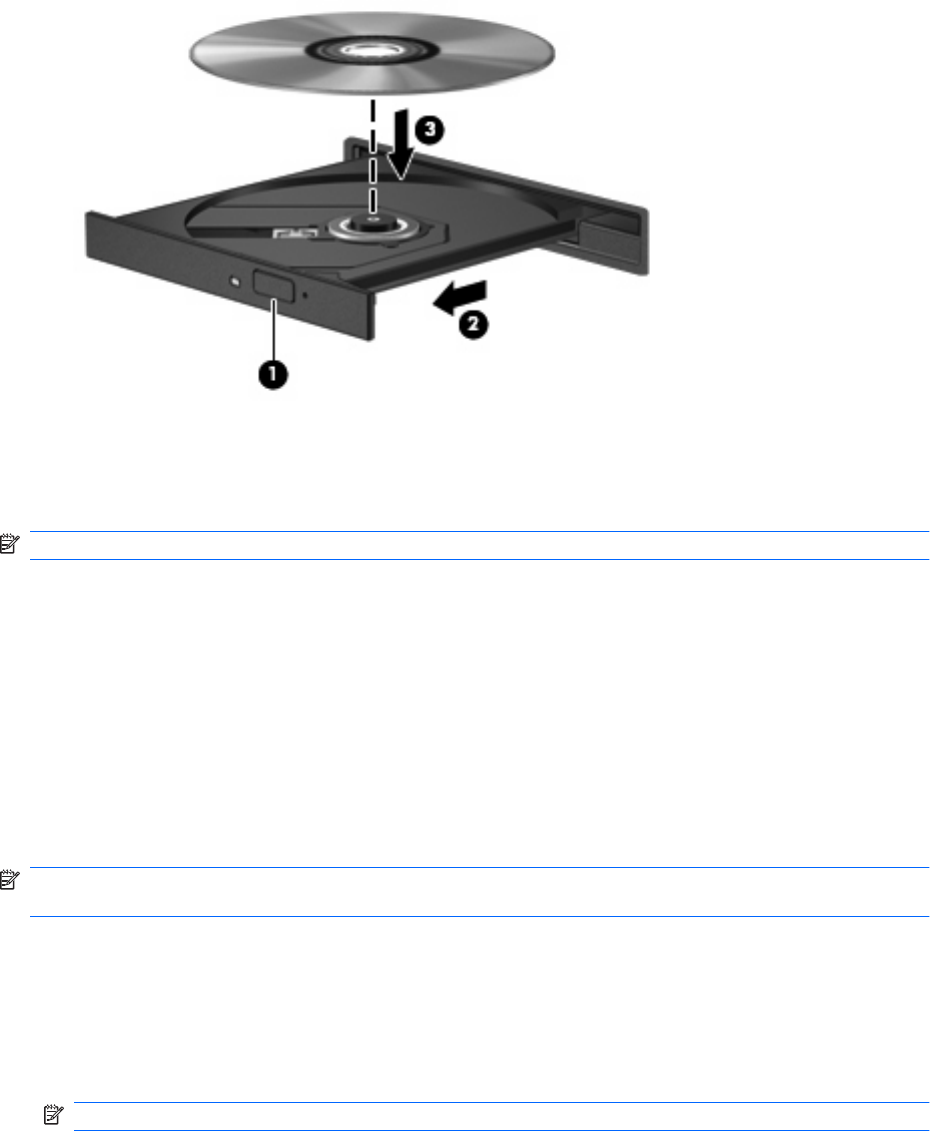
5. Gently press the disc (3) down onto the tray spindle until the disc snaps into place.
6. Close the disc tray.
7. If you have not yet configured AutoPlay, the AutoPlay dialog box opens and asks how you want to
use the media content. Choose Windows Media Player, which is preinstalled on your computer.
NOTE: After you insert a disc, a short pause is normal.
If Standby or Hibernation is accidentally initiated during playback of a disc:
●Your playback may be interrupted.
●You may see a warning message asking if you want to continue. If this message is displayed, click
No.
●You may need to restart the CD or DVD to resume playback.
Watching a movie
An external optical drive allows you to watch movies from a disc.
NOTE: Be sure that the external optical drive is connected to your computer before beginning these
steps.
1. Turn on the computer.
2. Press the release button (1) on the external optical drive bezel to release the disc tray.
3. Pull out the tray (2).
4. Hold the disc by the edges and position the disc label-side up over the tray spindle.
NOTE: If the tray is not fully accessible, tilt the disc carefully to position it over the spindle.
Optical drive (select models only) 43
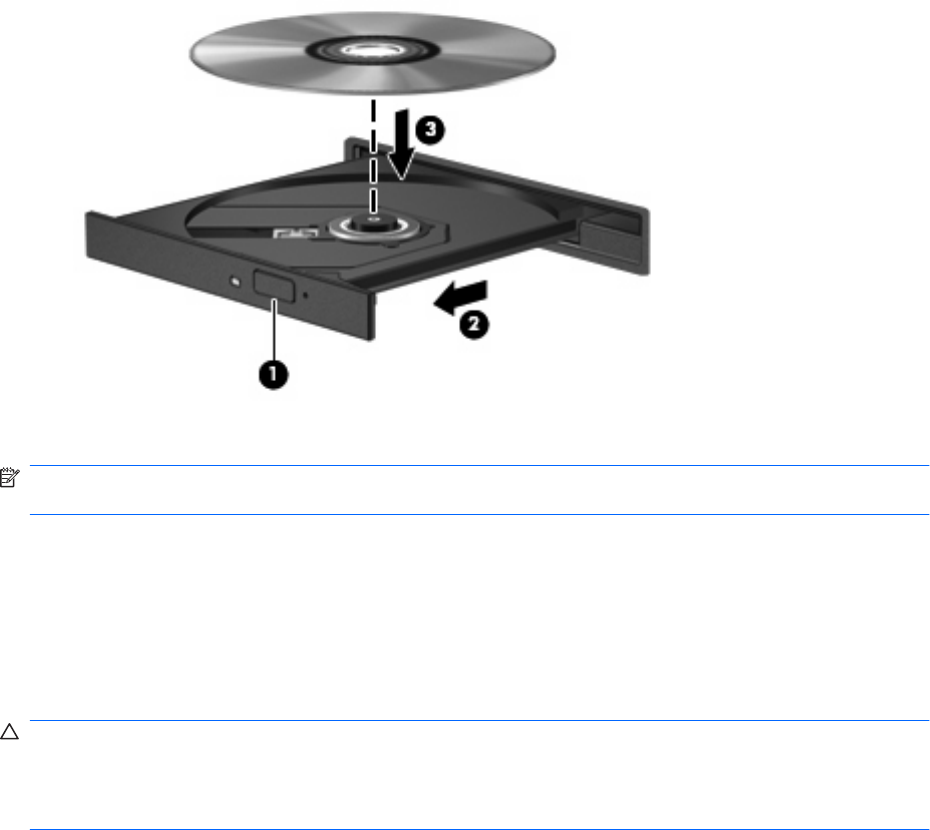
5. Gently press the disc (3) down onto the tray spindle until the disc snaps into place.
6. Close the disc tray.
NOTE: After you insert a disc, a short pause is normal. If you have not selected a media player, an
AutoPlay dialog box opens. It prompts you to select how you want to use the media content.
Changing DVD region settings
Most DVDs that contain copyrighted files also contain region codes. The region codes help protect
copyrights internationally.
You can play a DVD containing a region code only if the region code on the DVD matches the region
setting on your DVD drive.
CAUTION: The region settings on your DVD drive can be changed only 5 times.
The region setting you select the fifth time becomes the permanent region setting on the DVD drive.
The number of region changes remaining is displayed on the DVD Region tab.
To change settings through the operating system:
1. Select Start > My Computer.
2. Right-click in the window and select Properties > Hardware tab > Device Manager.
3. Click the "+" sign next to DVD/CD-ROM drives, right-click the DVD drive for which you want to
change region settings, and then click Properties.
4. Make the desired changes on the DVD Region tab.
5. Click OK.
Creating or “burning” a CD or DVD
If your external optical drive is a CD-RW, DVD-RW, or DVD±RW optical drive, you can use software
such as Windows Media Player to burn data and audio files, including MP3 and WAV music files. To
burn video files to a CD or DVD, use MyDVD.
44 Chapter 4 Multimedia

Observe the following guidelines when burning a CD or DVD:
●Before burning a disc, save and close any open files and close all programs.
●A CD-R or DVD-R is usually best for burning audio files because after the information is copied, it
cannot be changed.
●Because some home and car stereos will not play CD-RWs, use CD-Rs to burn music CDs.
●A CD-RW or DVD-RW is generally best for burning data files or for testing audio or video recordings
before you burn them to a CD or DVD that cannot be changed.
●DVD players used in home systems usually do not support all DVD formats. Refer to the user guide
that came with your DVD player for a list of supported formats.
●An MP3 file uses less space than other music file formats, and the process for creating an MP3
disc is the same as the process for creating a data file. MP3 files can be played only on MP3 players
or on computers with MP3 software installed.
To burn a CD or DVD, follow these steps:
1. Download or copy the source files into a folder on your hard drive.
2. Insert a blank CD or DVD into the external optical drive.
3. Select Start > All Programs and the name of the software you want to use.
4. Select the kind of CD or DVD you want to create—data, audio, or video.
5. Right-click Start, click Explore, and navigate to the folder where the source files are stored.
6. Open the folder, and then drag the files to the drive that contains the blank optical disc.
7. Initiate the burning process as directed by the program you have selected.
For specific instructions, refer to the software manufacturer's instructions, which may be provided with
the software, on disc, or on the manufacturer's Web site.
CAUTION: Observe the copyright warning. It is a criminal offense, under applicable copyright laws,
to make unauthorized copies of copyright-protected material, including computer programs, films,
broadcasts, and sound recordings. Do not use this computer for such purposes.
Removing an optical disc (CD or DVD)
1. Press the release button (1) on the drive bezel to release the disc tray, and then gently pull out the
tray (2) until it stops.
Optical drive (select models only) 45
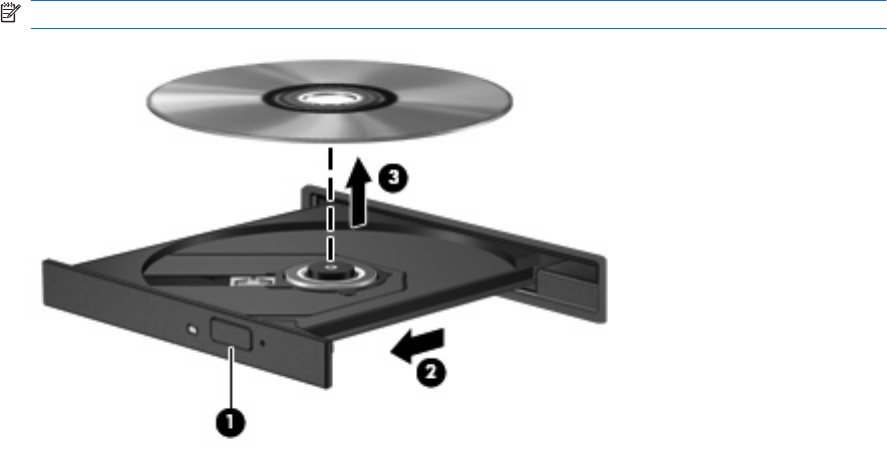
2. Remove the disc (3) from the tray by gently pressing down on the spindle while lifting the outer
edges of the disc. Hold the disc by the edges and avoid touching the flat surfaces.
NOTE: If the tray is not fully accessible, tilt the disc carefully as you remove it.
3. Close the disc tray and place the disc in a protective case.
46 Chapter 4 Multimedia

Webcam
Your computer model includes an integrated webcam, located at the top of the display. The webcam
can be used with a variety of software for the following functions:
●Capturing video
●Streaming video with instant message software
●Taking still photos
NOTE: Be sure that you have installed software that is designed for use with the integrated webcam.
NOTE: For information about using software designed for use with the integrated webcam, refer to
the online Help for that software.
For optimum performance, observe the following guidelines while using the integrated webcam:
●Be sure that you have the latest version of an instant message program before attempting a video
conversation.
●The webcam may not work properly across some network firewalls.
NOTE: If you are having trouble viewing or sending multimedia files to someone on another LAN
or outside your network firewall, temporarily disable the firewall, perform the task you want to
perform, and then reenable the firewall. To permanently resolve the problem, reconfigure the
firewall as necessary, and adjust the policies and settings of other intrusion detection systems. For
additional information, contact your network administrator or IT department.
●Whenever possible, place bright light sources behind the webcam and out of the picture area.
Adjusting webcam properties
You can adjust webcam properties using the Properties dialog box, which is accessible from various
programs that use the integrated webcam, usually from a configuration, settings, or properties menu:
●Brightness—Controls the amount of light that is incorporated into the image. A higher brightness
setting creates a brighter image; a lower brightness setting creates a darker image.
●Contrast—Controls the difference between lighter and darker areas on the image. A higher
contrast setting intensifies the image; a lower contrast setting maintains more of the original
information’s dynamic range but leads to a flatter image.
●Hue—Controls the aspect of color that distinguishes it from another color (what makes a color red,
green, or blue). Hue is distinct from saturation, which measures the intensity of the hue.
●Saturation—Controls the strength of color in the final image. A higher saturation setting creates a
bolder image; a lower saturation setting creates a more subtle image.
●Sharpness—Controls the definition of edges in an image. A higher sharpness setting creates a
more defined image; a lower sharpness setting creates a softer image.
●Gamma—Controls the contrast affecting the mid-level grays or midtones of an image. Adjusting
the gamma of an image allows you to change the brightness values of the middle range of gray
tones without dramatically altering the shadows and highlights. A lower gamma setting makes
grays look black, and makes dark colors even darker.
For information about using the webcam, select Start > Help and Support.
Webcam 47

5Security
Protecting the computer
NOTE: Security solutions are designed to act as deterrents. These deterrents may not prevent a
product from being mishandled or stolen.
NOTE: In some countries or regions, the computer supports CompuTrace, which is an online-security-
based tracking and recovery service. If the computer is stolen, CompuTrace can track the computer if
the unauthorized user accesses the Internet. You must purchase the software and subscribe to the
service in order to use CompuTrace. For information about ordering the CompuTrace software, see the
HP Web site at http://www.hpshopping.com.
Security features provided with your computer can protect the computer, personal information, and data
from a variety of risks. The way you use your computer will determine which security features you need
to use.
The Windows operating system offers certain security features. Additional security features are listed
in the following table. Most of these additional security features can be configured in the Computer Setup
utility.
To protect against Use this security feature
Unauthorized use of the computer Power-on authentication using passwords or smart cards
Unauthorized access to Computer Setup (f10)Setup password in Computer Setup*
Unauthorized access to the contents of a hard drive DriveLock password in Computer Setup*
Unauthorized reset of Computer Setup (f10) passwords Stringent security feature in Computer Setup*
Unauthorized startup from an optical drive, diskette drive, or
internal network adapter
Boot options feature in Computer Setup*
Unauthorized access to data ●Firewall software
●Windows updates
Unauthorized access to Computer Setup settings and other
system identification information
Setup password in Computer Setup*
Unauthorized removal of the computer Security cable slot (used with an optional security cable)
*Computer Setup is a non-Windows utility accessed by pressing f10 when the computer is turned on or restarted. When using
Computer Setup, you must use the keys on your computer to navigate and make selections.
48 Chapter 5 Security

Using passwords
A password is a group of characters that you choose to secure your computer information. Several types
of passwords can be set, depending on how you want to control access to your information. Passwords
can be set in Windows or in the non-Windows Computer Setup utility preinstalled on the computer.
CAUTION: To prevent being locked out of the computer, record each password you set. Because
most passwords are not displayed as they are set, changed, or deleted, it is essential to record each
password immediately and store it in a secure place.
You can use the same password for a Computer Setup feature and for a Windows security feature. You
can also use the same password for more than one Computer Setup feature.
Use the following guidelines when setting a password in Computer Setup:
●A password can be any combination of up to 8 letters and numbers and is case sensitive.
●A password set in Computer Setup must be entered at a Computer Setup prompt. A password set
in Windows must be entered at a Windows prompt.
Use the following tips for creating and saving passwords:
●When creating passwords, follow requirements set by the program.
●Write down your passwords and store them in a secure place away from the computer.
●Do not store passwords in a file on the computer.
●Do not use your name or other personal information that could be easily discovered by an outsider.
The following sections list Windows and Computer Setup passwords and describe their functions. For
additional information about Windows passwords, such as screen-saver passwords, select Start > Help
and Support.
Setting passwords in Windows
Windows passwords Function
Administrator password* Protects access to a Windows administrator-level account.
User password* Protects access to a Windows user account.
*For information about setting a Windows administrator password or a Windows user password, select Start > Help and
Support.
Setting passwords in Computer Setup
Computer Setup passwords Function
Setup password Protects access to Computer Setup.
Power-on password Protects access to the computer contents when the computer
turns on, restarts, or exits Hibernation.
Using passwords 49

Computer Setup passwords Function
DriveLock master password Protects access to the internal hard drive that is protected by
DriveLock. It is also used to remove DriveLock protection. This
password is set under DriveLock Passwords during the enable
process.
DriveLock user password Protects access to the internal hard drive that is protected by
DriveLock, and is set under DriveLock Passwords during the
enable process.
Setup password
The Computer Setup setup password protects the configuration settings and system identification
information in Computer Setup. After this password is set, it must be entered to access Computer Setup
and to make changes using Computer Setup.
Note the following characteristics of the setup password:
●It is not interchangeable with a Windows administrator password, although both passwords can be
identical.
●It is not displayed as it is set, entered, changed, or deleted.
●It must be set and entered with the same keys. For example, a setup password set with keyboard
number keys will not be recognized if you enter it thereafter with embedded numeric keypad number
keys.
●It can include any combination of up to 32 letters and numbers and is not case sensitive.
50 Chapter 5 Security
Managing a setup password
A setup password is set, changed, and deleted in Computer Setup.
To manage, set, change, or delete this password, follow these steps:
1. Open Computer Setup by turning on or restarting the computer, and then pressing f10 while the
“F10 = ROM Based Setup” message is displayed in the lower-left corner of the screen.
2. Use the arrow keys to select Security > Setup password, and then press enter.
●To set a setup password, type your password in the New password and Verify new
password fields, and then press f10.
●To change a setup password, type your current password in the Old password field, type a
new password in the New password and Verify new password fields, and then press f10.
●To delete a setup password, type your current password in the Old password field, and then
press f10.
3. To save your preferences, use the arrow keys to select File > Save changes and exit. Then follow
the instructions on the screen.
Your preferences go into effect when the computer restarts.
Using passwords 51
Entering a setup password
At the Setup password prompt, type your setup password (using the same kind of keys you used to
set the password), and then press enter. After 3 unsuccessful attempts to enter the setup password,
you must restart the computer and try again.
Power-on password
The Computer Setup power-on password prevents unauthorized use of the computer. After this
password is set, it must be entered each time the computer is turned on.
Note the following characteristics of a power-on password:
●It is not displayed as it is set, entered, changed, or deleted.
●It must be set and entered with the same keys. For example, a power-on password set with
keyboard number keys will not be recognized if you enter it thereafter with embedded numeric
keypad number keys.
●It can include any combination of up to 32 letters and numbers and is not case sensitive.
52 Chapter 5 Security
Managing a power-on password
A power-on password is set, changed, and deleted in Computer Setup.
To manage, set, change, or delete this password, follow these steps:
1. Open Computer Setup by turning on or restarting the computer, and then pressing f10 while the
“F10 = ROM Based Setup” message is displayed in the lower-left corner of the screen.
2. Use the arrow keys to select Security > Power-On password, and then press enter.
●To set a power-on password, type the password in the New password and Verify new
password fields, and then press f10.
●To change a power-on password, type the current password in the Old password field, type
the new password in the New password and Verify new password fields, and then press
f10.
●To delete a power-on password, type the current password in the Old password field, and
then press f10.
3. To save your preferences, use the arrow keys to select File > Save changes and exit. Then follow
the instructions on the screen.
Your preferences go into effect when the computer restarts.
Using passwords 53
Entering a power-on password
At the Power-on Password prompt, type your password (using the same kind of keys you used to set
the password), and then press enter. After 3 unsuccessful attempts to enter the password, you must
turn off the computer, turn it back on, and then try again.
54 Chapter 5 Security

Requiring a power-on password at restart
In addition to requiring that a power-on password be entered each time the computer is turned on, you
can also require that a power-on password be entered each time the computer is restarted.
To enable and disable this feature in Computer Setup, follow these steps:
1. Open Computer Setup by turning on or restarting the computer, and then pressing f10 while the
“F10 = ROM Based Setup” message is displayed in the lower-left corner of the screen.
2. Use the arrow keys to select Security > Password options, and then press enter.
3. Use the arrow keys to select Enable or Disable in the Require password on restart field, and
then press f10.
4. To save your preferences, use the arrow keys to select File > Save changes and exit. Then follow
the instructions on the screen.
Using Computer Setup DriveLock
CAUTION: To prevent the DriveLock-protected hard drive from becoming permanently unusable,
record the DriveLock user password and the DriveLock master password in a safe place away from your
computer. If you forget both DriveLock passwords, the hard drive will be permanently locked and can
no longer be used.
DriveLock protection prevents unauthorized access to the contents of a hard drive. DriveLock can be
applied only to the internal hard drive(s) of the computer. After DriveLock protection is applied to a drive,
a password must be entered to access the drive. The drive must be inserted into the computer, not into
an optional docking device or external MultiBay, in order for it to be accessed by the DriveLock
passwords.
To apply DriveLock protection to an internal hard drive, a user password and a master password must
be set in Computer Setup. Note the following considerations about using DriveLock protection:
●After DriveLock protection is applied to a hard drive, the hard drive can be accessed only by entering
either the user password or the master password.
●The owner of the user password should be the day-to-day user of the protected hard drive. The
owner of the master password may be either a system administrator or the day-to-day user.
●The user password and the master password can be identical.
●You can delete a user password or master password only by removing DriveLock protection from
the drive. DriveLock protection can be removed from the drive only with the master password.
NOTE: When your power-on password and DriveLock user password are identical, you will be
prompted to enter only a power-on password instead of both a power-on password and a DriveLock
user password.
Using passwords 55
Setting a DriveLock password
To access the DriveLock settings in Computer Setup, follow these steps:
1. Open Computer Setup by turning on or restarting the computer, and then pressing f10 while the
“F10 = ROM Based Setup” message is displayed in the lower-left corner of the screen.
2. Use the arrow keys to select Security > DriveLock passwords, and then press enter.
3. Select the location of the hard drive you want to protect, and then press f10.
4. Use the arrow keys to select Enable in the Protection field, and then press f10.
5. Read the warning. To continue, press f10.
6. Type your user password in the New password and Verify new password fields, and then press
f10.
7. Type your master password in the New password and Verify new password fields, and then
press f10.
8. To confirm DriveLock protection on the drive you have selected, type DriveLock in the
confirmation field, and then press f10.
9. To exit DriveLock settings, use the arrow keys to select Esc.
10. To save your preferences, use the arrow keys to select File > Save changes and exit. Then follow
the instructions on the screen.
Your preferences go into effect when the computer restarts.
56 Chapter 5 Security
Entering a DriveLock password
Be sure that the hard drive is inserted into the computer (not into an optional docking device or external
MultiBay).
At the DriveLock Password prompt, type your user or master password (using the same kind of keys
you used to set the password), and then press enter.
After 2 incorrect attempts to enter the password, you must shut down the computer and try again.
Using passwords 57
Changing a DriveLock password
To access the DriveLock settings in Computer Setup, follow these steps:
1. Open Computer Setup by turning on or restarting the computer, and then pressing f10 while the
“F10 = ROM Based Setup” message is displayed in the lower-left corner of the screen.
2. Use the arrow keys to select Security > DriveLock passwords, and then press enter.
3. Use the arrow keys to select the location of the internal hard drive, and then press f10.
4. Use the arrow keys to select the field for the password you want to change. Type your current
password in the Old password field, and then type the new password in the New password field
and in the Verify new password field. Then press f10.
5. To save your preferences, use the arrow keys to select File > Save changes and exit. Then follow
the instructions on the screen.
Your preferences go into effect when the computer restarts.
58 Chapter 5 Security
Removing DriveLock protection
To access the DriveLock settings in Computer Setup, follow these steps:
1. Open Computer Setup by turning on or restarting the computer, and then pressing f10 while the
“F10 = ROM Based Setup” message is displayed in the lower-left corner of the screen.
2. Use the arrow keys to select Security > DriveLock passwords, and then press enter.
3. Use the arrow keys to select the location of the internal hard drive, and then press f10.
4. Use the arrow keys to select Disable in the Protection field, and then press f10.
5. Type your master password in the Old password field. Then press f10.
6. To save your preferences, use the arrow keys to select File > Save changes and exit. Then follow
the instructions on the screen.
Your preferences go into effect when the computer restarts.
Using passwords 59

Using Computer Setup security features
Securing system devices
From the Boot options menu or the Port options menu in Computer Setup, you can disable or enable
system devices.
To disable or reenable system devices in Computer Setup, follow these steps:
1. Open Computer Setup by turning on or restarting the computer, and then pressing f10 while the
“F10 = ROM Based Setup” message is displayed in the lower-left corner of the screen.
2. Use the arrow keys to select System Configuration > Boot options or System Configuration
> Port options. Then press enter and use the arrow keys to select the options you want.
3. To confirm your preferences, press f10.
4. To save your preferences, use the arrow keys to select File > Save changes and exit. Then follow
the instructions on the screen.
Your preferences go into effect when the computer restarts.
Using Computer Setup stringent security
CAUTION: To prevent the computer from becoming permanently unusable, record your configured
setup password, power-on password, or smart card PIN in a safe place away from your computer.
Without these passwords or PIN, the computer cannot be unlocked.
The stringent security feature enhances power-on security by forcing user authentication with your
configured setup password, power-on password, or smart card PIN before granting access to the
system.
60 Chapter 5 Security
Setting stringent security
To enable stringent security in Computer Setup, follow these steps:
1. Open Computer Setup by turning on or restarting the computer, and then pressing f10 while the
“F10 = ROM Based Setup” message is displayed in the lower-left corner of the screen.
2. Use the arrow keys to select Security > Password options, and then press enter.
3. Use the arrow keys to select Enable in the Stringent security field.
4. Read the warning. To continue, press f10.
5. To enable the feature each time the computer is turned on, press f10.
6. To save your preferences, use the arrow keys to select File > Save changes and exit. Then follow
the instructions on the screen.
Your preferences go into effect when the computer restarts.
Using Computer Setup security features 61

Removing stringent security
To remove stringent security in Computer Setup, follow these steps:
1. Open Computer Setup by turning on or restarting the computer, and then pressing f10 while the
“F10 = ROM Based Setup” message is displayed in the lower-left corner of the screen.
2. Use the arrow keys to select Security > Password options and then press enter.
3. Use the arrow keys to select Disable in the Stringent security field, and then press f10.
4. To save your preferences, use the arrow keys to select File > Save changes and exit. Then follow
the instructions on the screen.
Your preferences go into effect when the computer restarts.
Viewing Computer Setup System Information
The System Information feature in Computer Setup provides 2 types of system information:
●Identification information about the computer model.
●Specification information for the processor, cache and memory size, and system ROM.
To view this general system information, follow these steps:
1. Open Computer Setup by turning on or restarting the computer, and then pressing f10 while the
“F10 = ROM Based Setup” message is displayed in the lower-left corner of the screen.
2. Use the arrow keys to select File > System Information, and then press enter.
NOTE: To prevent unauthorized access to this information, you must create a setup password in
Computer Setup.
62 Chapter 5 Security
Using antivirus software
When you use the computer to access e-mail, a network, or the Internet, you expose the computer to
computer viruses. Computer viruses can disable the operating system, applications, or utilities, or cause
them to function abnormally.
Antivirus software can detect most viruses, destroy them, and in most cases, repair any damage they
have caused. To provide ongoing protection against newly discovered viruses, antivirus software must
be updated.
For more information about computer viruses, type viruses in the Search box in Help and Support.
Using antivirus software 63

Using firewall software
When you use the computer to access e-mail, a network, or the Internet, unauthorized persons may be
able to gain access to information about you, the computer, and your personal files. Use the firewall
software preinstalled on the computer to protect your privacy.
Firewall features include information on logging and reporting, and automatic alarms to monitor all
incoming and outgoing traffic. Refer to the firewall documentation or contact your firewall manufacturer
for more information.
NOTE: Under some circumstances a firewall can block access to Internet games, interfere with printer
or file sharing on a network, or block authorized e-mail attachments. To temporarily solve the problem,
disable the firewall, perform the task that you want to perform, and then reenable the firewall. To
permanently resolve the problem, reconfigure the firewall.
64 Chapter 5 Security

Installing critical updates
CAUTION: To protect the computer from security breaches and computer viruses, install the online
critical updates from Microsoft as soon as you receive an alert.
Updates to the operating system and other software may have become available after the computer
was shipped. To be sure that all available updates are installed on the computer, observe these
guidelines:
●Run Windows Update monthly to install the latest software from Microsoft.
●Obtain updates, as they are released, from the Microsoft Web site and through the updates link in
Help and Support.
Installing critical updates 65
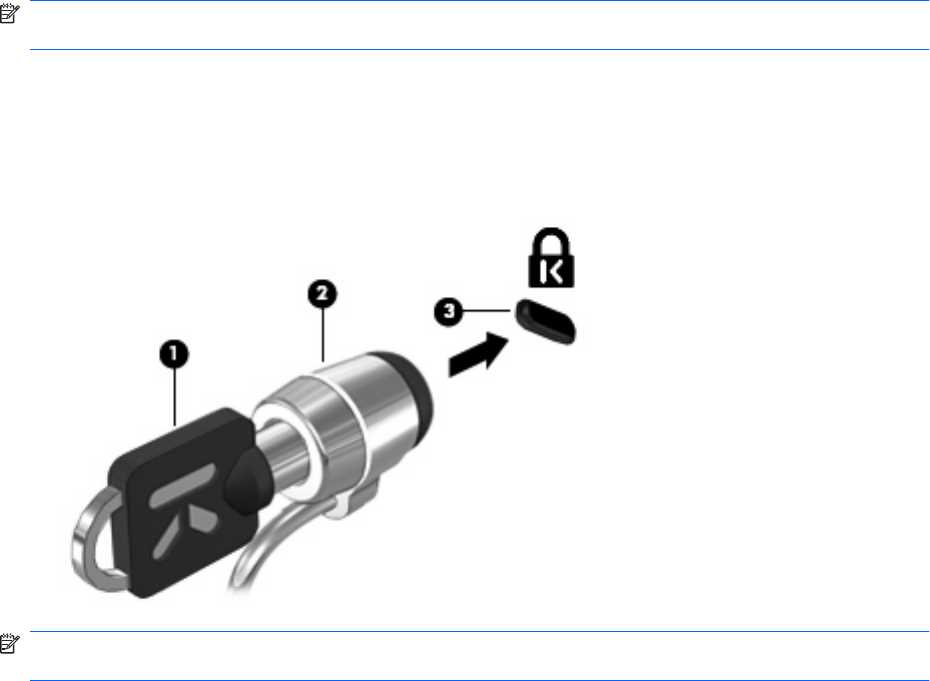
Installing a security cable
NOTE: The security cable is designed to act as a deterrent, but it may not prevent the computer from
being mishandled or stolen.
1. Loop the security cable around a secured object.
2. Insert the key (1) into the cable lock (2).
3. Insert the cable lock into the security cable slot on the computer (3), and then lock the cable lock
with the key.
NOTE: Your computer may look different from the illustration. The location of the security cable slot
varies by model.
66 Chapter 5 Security
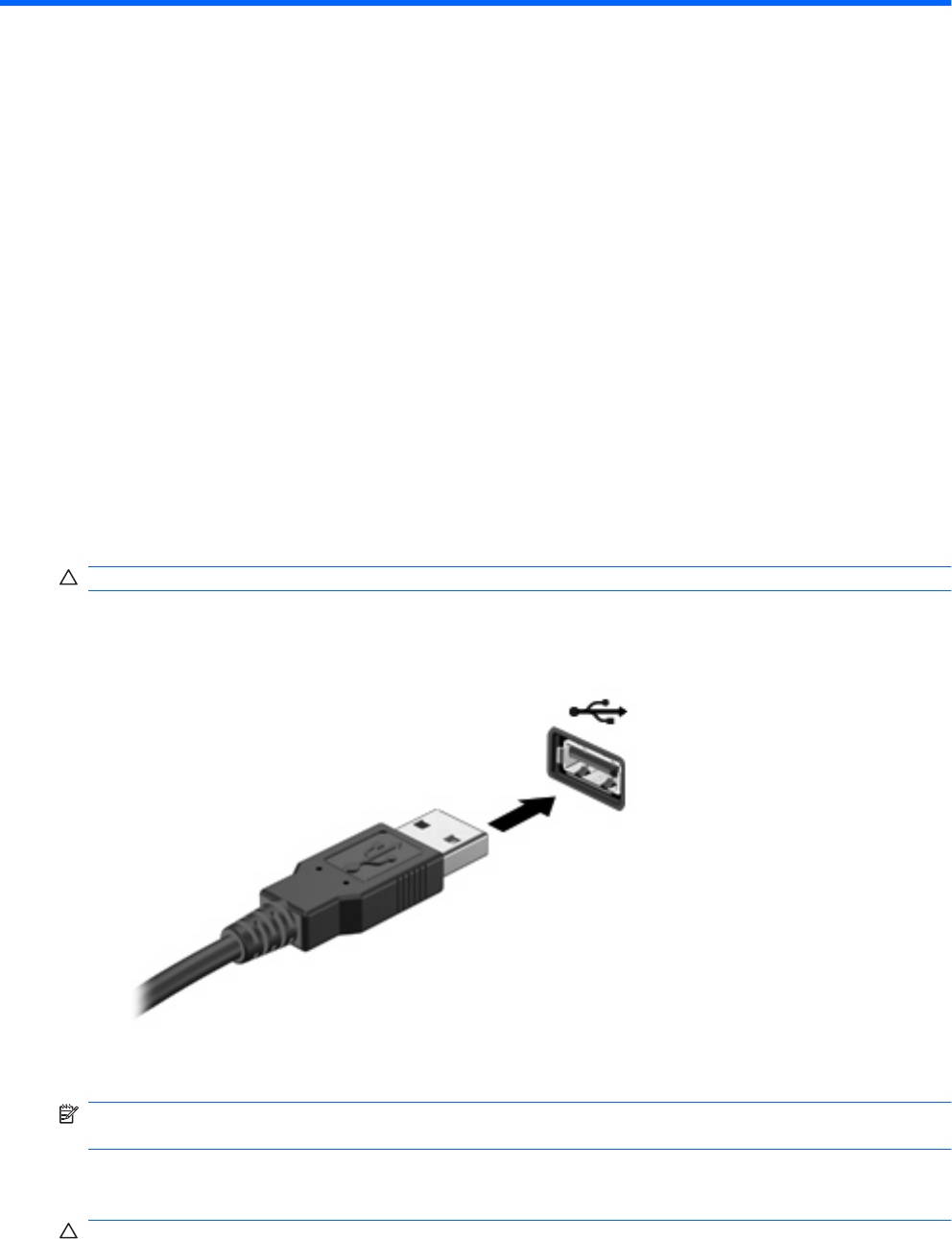
6 External devices
Using a USB device
Universal Serial Bus (USB) is a hardware interface that can be used to connect an optional external
device, such as a USB keyboard, mouse, drive, printer, scanner, or hub.
Some USB devices may require additional support software, which is usually included with the device.
For more information about device-specific software, refer to the manufacturer's instructions.
Your computer model has 2 USB ports, which support USB 1.0, USB 1.1, and USB 2.0 devices. A USB
hub provides additional USB ports that can be used with the computer.
Connecting a USB device
CAUTION: To prevent damage to a USB connector, use minimal force to connect a USB device.
▲To connect a USB device to the computer, connect the USB cable for the device to the USB
port.
You will hear a sound when the device has been detected.
NOTE: The first time you connect a USB device, a message is displayed in the notification area to let
you know the device is recognized by the computer.
Stopping and removing a USB device
CAUTION: To prevent loss of information or an unresponsive system, stop a USB device before
removing it.
Using a USB device 67

CAUTION: To prevent damage to a USB connector, do not pull on the cable to remove the USB device.
To stop and remove a USB device:
1. Double-click the Safely Remove Hardware icon in the notification area, at the far right of the
taskbar.
NOTE: To display the Safely Remove Hardware icon, click the Show Hidden Icons icon (< or
<<) in the notification area.
2. Click the name of the device in the list.
NOTE: If the USB device is not listed, you do not have to stop the device before you remove it.
3. Click Stop, and then click OK.
4. Remove the device.
Using USB legacy support
USB legacy support (enabled by default) permits the following actions:
●Using a USB keyboard, mouse, or hub connected to a USB port on the computer during startup or
in an MS-DOS-based program or utility
●Starting or restarting from an optional external MultiBay or an optional USB bootable device
USB legacy support is enabled at the factory. To disable or enable USB legacy support:
1. Open Computer Setup by turning on or restarting the computer, and then pressing f10 while the
“F10 = ROM Based Setup” message is displayed in the lower-left corner of the screen.
2. Use the arrow keys to select System Configuration > Device configurations, and then press
enter.
3. Use the arrow keys to enable or disable USB legacy support, and then press f10.
4. To save your preferences and exit Computer Setup, use the arrow keys to select File > Save
changes and exit. Then follow the instructions on the screen.
Your preferences go into effect when the computer restarts.
68 Chapter 6 External devices

Using external drives
Removable external drives expand your options for storing and accessing information. A USB drive can
be added by connecting the drive to a USB port on the computer.
NOTE: HP external USB optical drives should be connected to the powered USB port on the left side
of the computer.
USB drives include the following types:
●1.44-megabyte diskette drive
●Hard drive module (a hard drive with an adapter attached)
●DVD-ROM Drive
●DVD/CD-RW Combo Drive
●DVD+RW and CD-RW Combo Drive
●DVD±RW/CD-RW Combo Drive
●MultiBay device
Using optional external devices
NOTE: For more information about required software and drivers, or to learn which computer port to
use, refer to the manufacturer's instructions.
To connect an external device to the computer:
CAUTION: To reduce the risk of damage to the equipment when connecting a powered device, be
sure that the device is turned off and the AC power cord is unplugged.
1. Connect the device to the computer.
2. If you are connecting a powered device, plug the device power cord into a grounded AC outlet.
3. Turn on the device.
To disconnect an unpowered external device, turn off the device, and then disconnect it from the
computer. To disconnect a powered external device, turn off the device, disconnect it from the computer,
and then unplug the AC power cord.
Using an optional external MultiBay II
An MultiBay II connects to a USB port on the computer and enables you to use MultiBay II devices. The
computer provides one powered USB port on the left side of the computer. This port provides power to
the external MultiBay when used with a powered USB cable. An external MultiBay connected to the
other USB port on the computer must be connected to AC power.
For more information about the external MultiBay, refer to the user guide that is included with the device.
Using external drives 69

Using an optional external optical drive (select models
only)
An external optical drive connects to a USB port on the computer and enables you to use optical discs
(CDs and DVDs). The computer provides one powered USB port on the left side of the computer. This
port provides power to the external optical drive when used with a powered USB cable. An external
optical drive connected to the other USB port on the computer must be connected to AC power.
An external optical drive, such as a DVD-ROM drive, supports optical discs (CDs and DVDs). These
discs store or transport information and play music and movies. DVDs have a higher storage capacity
than CDs.
All optical drives can read from optical discs and some drives can also write to optical discs as described
in the following table.
Optical drive type Read from CD and
DVD-ROM media
Write to CD-R/RW
media
Write to DVD
(includes DVD+R DL,
DVD±RW/R, and DVD-
RAM media)
Write label to
LightScribe CD or
DVD
DVD-ROM Drive Yes No No No
DVD/CD-RW Combo
Drive
Yes Yes No No
DVD±RW/CD-RW
Combo Drive
Yes Yes Yes No
NOTE: Some of the optical drives listed may not be supported by your computer. The listed drives are not necessarily all of
the supported optical drives.
CAUTION: To prevent possible audio and video degradation, or loss of audio or video playback
functionality, do not initiate Standby or Hibernation while reading from or writing to a CD or DVD.
To prevent loss of information, do not initiate Standby or Hibernation when writing to a CD or DVD.
If Standby or Hibernation is initiated during playback of a disc, you may experience the following
behaviors:
●Your playback may be interrupted.
●You may see a warning message asking if you want to continue. If this message is displayed, click
No.
●You may need to restart the CD or DVD to resume audio and video playback.
Inserting an optical disc (CD or DVD)
1. Turn on the computer.
2. Press the release button (1) on the drive bezel to release the disc tray.
3. Pull out the tray (2).
4. Hold the disc by the edges to avoid touching the flat surfaces and position the disc label-side up
over the tray spindle.
70 Chapter 6 External devices
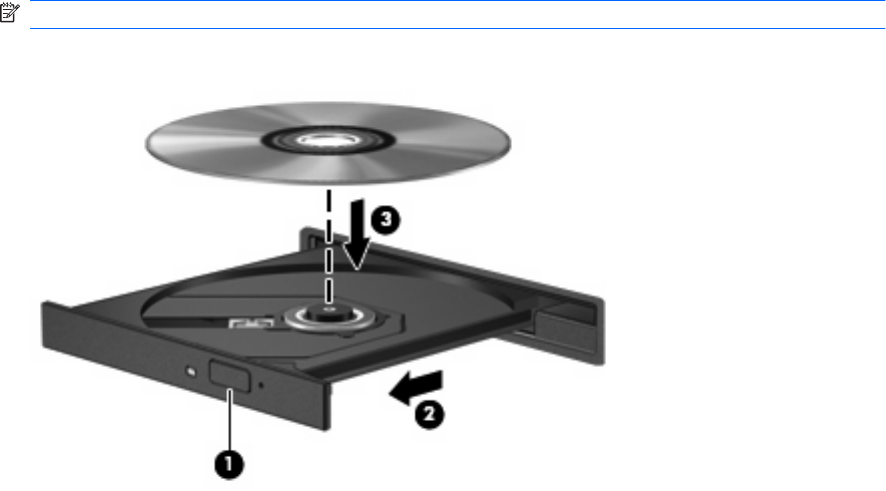
NOTE: If the tray is not fully accessible, tilt the disc carefully to position it over the spindle.
5. Gently press the disc (3) down onto the tray spindle until the disc snaps into place.
6. Close the disc tray.
Removing an optical disc (CD or DVD)
There are 2 ways to remove a disc, depending on whether the disc tray opens normally or not.
When the disc tray opens
1. Press the release button (1) on the drive bezel to release the disc tray, and then gently pull out the
tray (2) until it stops.
Using an optional external optical drive (select models only) 71
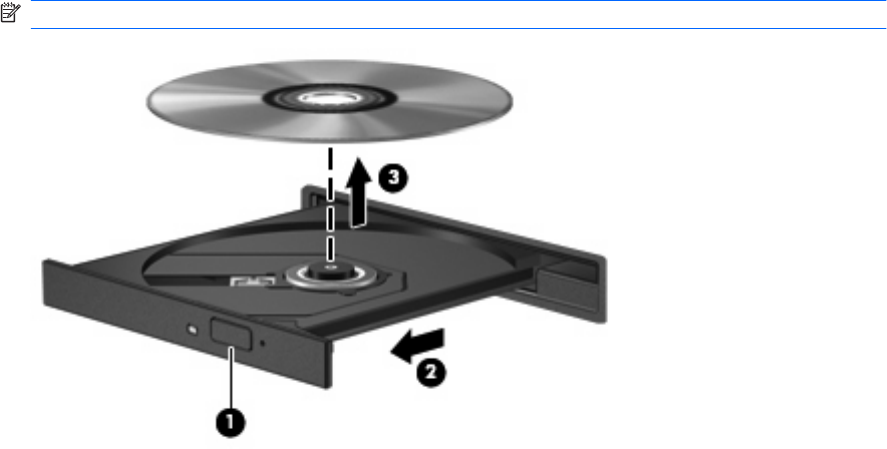
2. Remove the disc (3) from the tray by gently pressing down on the spindle while lifting the outer
edges of the disc. Hold the disc by the edges and avoid touching the flat surfaces.
NOTE: If the tray is not fully accessible, tilt the disc carefully as you remove it.
3. Close the disc tray and place the disc in a protective case.
When the disc tray does not open
1. Insert the end of a paper clip (1) into the release access in the front bezel of the drive.
2. Press in gently on the paper clip until the tray is released, and then pull out the tray (2) until it stops.
72 Chapter 6 External devices
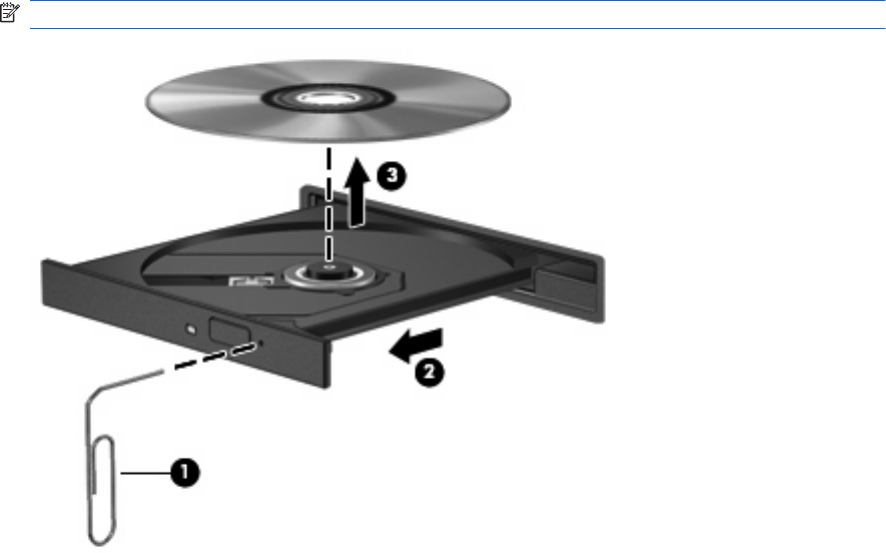
3. Remove the disc (3) from the tray by gently pressing down on the spindle while lifting the outer
edges of the disc. Hold the disc by the edges and avoid touching the flat surfaces.
NOTE: If the tray is not fully accessible, tilt the disc carefully as you remove it.
4. Close the disc tray and place the disc in a protective case.
Using an optional external optical drive (select models only) 73
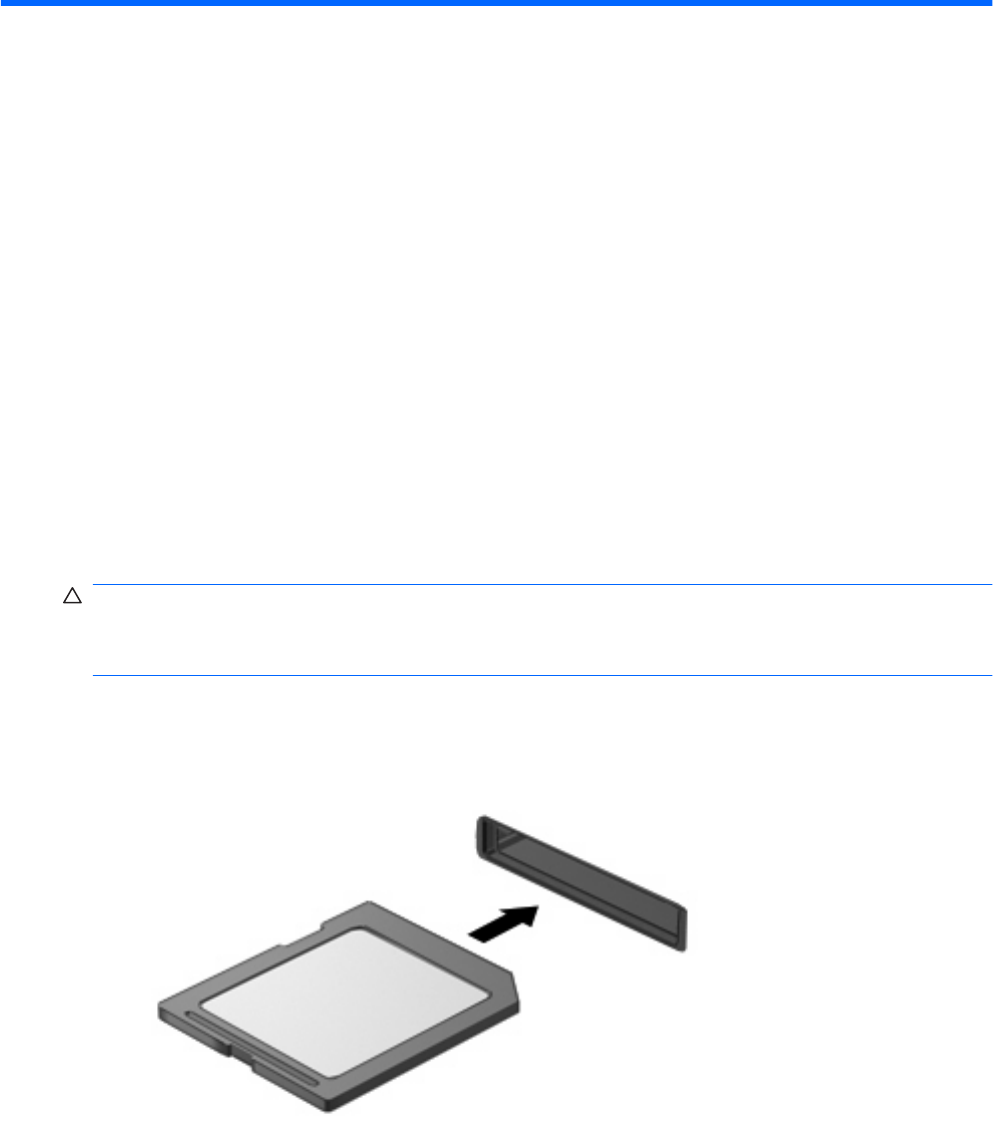
7 External media cards
Using SD Card Reader cards
Optional digital cards provide secure data storage and convenient data sharing. These cards are often
used with digital media–equipped cameras and PDAs as well as with other computers.
The SD Card Reader supports the following formats:
●MultiMediaCard (MMC)
●Secure Digital (SD) Memory Card
Inserting a digital card
CAUTION: To avoid damaging the digital card or the computer, do not insert any type of adapter into
the SD Card Reader.
CAUTION: To prevent damage to the digital card connectors, use minimal force to insert a digital card.
1. Hold the digital card label-side up, with the connectors facing the computer.
2. Insert the card into the SD Card Reader, and then push in on the card until it is firmly seated.
You will hear a sound when the device has been detected, and a menu of available options may
be displayed.
74 Chapter 7 External media cards
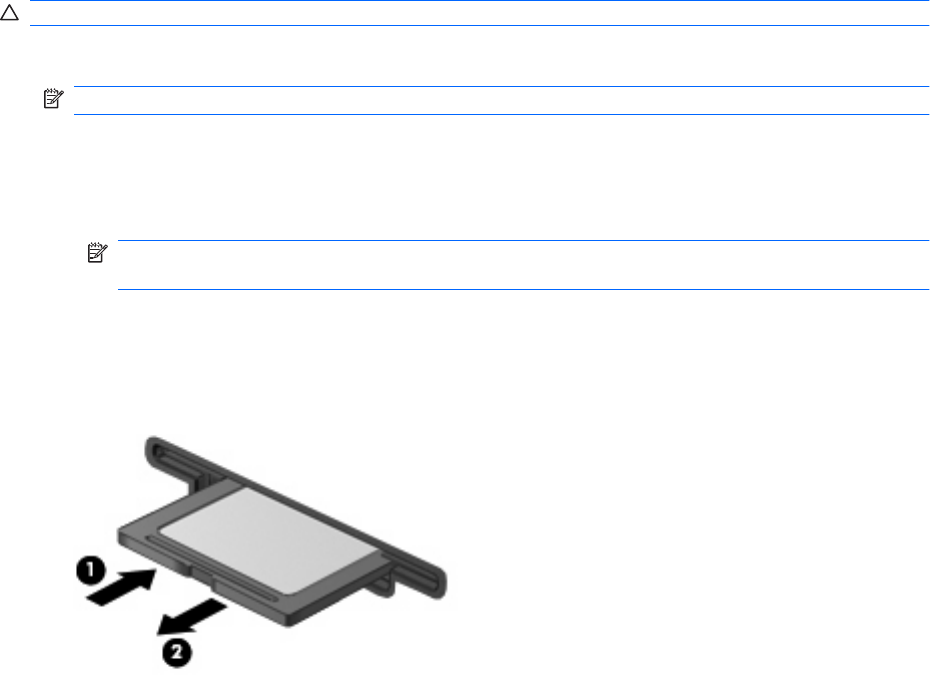
Stopping and removing a digital card
CAUTION: To prevent loss of data or an unresponsive system, stop a digital card before removing it.
1. Save your information and close all programs associated with the digital card.
NOTE: To stop a data transfer, click Cancel in the operating system Copying window.
2. Stop the digital card:
a. Double-click the Safely Remove Hardware icon in the notification area, at the far right of the
taskbar.
NOTE: To display the Safely Remove Hardware icon, click the Show Hidden Icons icon
(< or <<) in the notification area.
b. Click the name of the digital card in the list.
c. Click Stop, and then click OK.
3. Press in on the digital card (1), and then remove the card from the slot (2).
Using SD Card Reader cards 75

8 Pointing devices and keyboard
Using pointing devices
Setting pointing device preferences
Use Mouse Properties in Windows® to customize settings for pointing devices, such as button
configuration, click speed, and pointer options.
To access Mouse Properties, select Start > Control Panel > Printers and Other Hardware >
Mouse.
Using the TouchPad
To move the pointer, slide your finger across the TouchPad surface in the direction you want the pointer
to go. Use the TouchPad buttons like the corresponding buttons on an external mouse. To scroll up and
down using the TouchPad vertical scroll zone, slide your finger up or down over the lines.
NOTE: If you are using the TouchPad to move the pointer, you must lift your finger off the TouchPad
before moving it to the scroll zone. Simply sliding your finger from the TouchPad to the scroll zone will
not activate the scrolling function.
Connecting an external mouse
You can connect an external USB mouse to the computer using one of the USB ports on the computer.
A USB mouse can also be connected to the system using the ports on an optional docking device or
expansion product.
Using the keyboard function keys
The icons on the function keys f2 through f6 and f8, f10, and f11 keys represent the action performed
when a function key is pressed. The following table and sections describe the function keys.
NOTE: Your computer may look slightly different from the illustration in this section.
76 Chapter 8 Pointing devices and keyboard
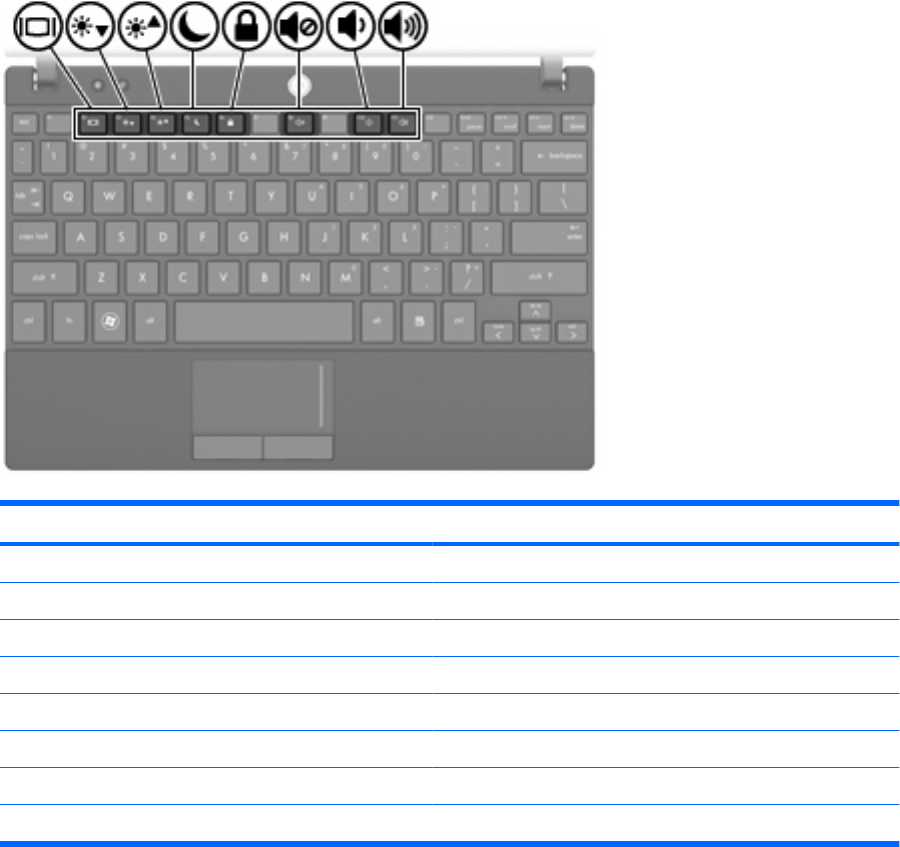
Function Key
Alternate between computer display and external display. f2
Decrease screen brightness. f3
Increase screen brightness. f4
Initiate Standby. f5
Initiate QuickLock. f6
Mute or restore computer sound. f8
Decrease computer sound. f10
Increase computer sound. f11
Using the keyboard function keys 77

Switching the screen image (f2)
Press f2 to switch the screen image among display devices connected to the system. For example, if a
monitor is connected to the computer, pressing f2 alternates the screen image from computer display
to monitor display to simultaneous display on both the computer and the monitor.
Most external monitors receive video information from the computer using the external VGA video
standard. Pressing f2 can also alternate images among other devices receiving video information from
the computer.
The following video transmission types, with examples of devices that use them, are supported by the
f2key:
●LCD (computer display)
●External VGA (most external monitors)
Decreasing screen brightness (f3)
Press f3 to decrease screen brightness. Hold down the key to decrease the brightness level
incrementally.
Increasing screen brightness (f4)
Press f4 to increase screen brightness. Hold down the key to increase the brightness level
incrementally.
Initiating Standby (f5)
Press f5 to initiate Standby.
When Standby is initiated, your information is stored in system memory, the screen is cleared, and power
is conserved. While the computer is in the Sleep state, the power lights blink.
CAUTION: To reduce the risk of information loss, save your work before initiating Standby.
The computer must be on before you can initiate Standby.
To exit Standby, briefly press the power button or press any key on the keyboard.
The function of the f5 key can be changed. For example, you can set the f5 key to initiate Hibernation
instead of Standby.
Initiating QuickLock (f6)
Press f6 to initiate the QuickLock security feature.
QuickLock protects your information by displaying the operating system Log On window. While the Log
On window is displayed, the computer cannot be accessed until a password is entered.
NOTE: Before you can use QuickLock, you must set a password.
To use QuickLock, press f6 to display the Log On window and lock the computer. Then follow the
instructions on the screen to enter your password and access the computer.
78 Chapter 8 Pointing devices and keyboard
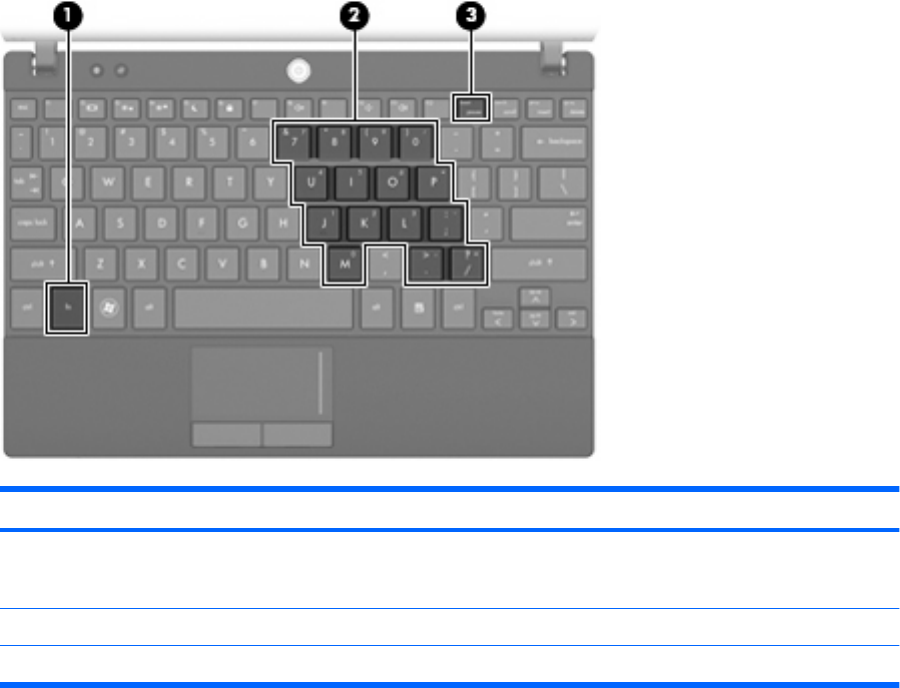
Muting speaker sound (f8)
Press f8 to mute speaker sound. Press the key again to restore speaker sound.
Decreasing speaker sound (f10)
Press f10 to decrease speaker sound. Hold down the key to decrease speaker sound incrementally.
Increasing speaker sound (f11)
Press f11 to increase speaker sound. Hold down the key to increase speaker sound incrementally.
Using keypads
The computer has an embedded numeric keypad and also supports an optional external numeric keypad
or an optional external keyboard that includes a numeric keypad.
Component Description
(1) fn key Alternates the functions of the keys on the embedded numeric
keypad when pressed in combination with a keypad key or the
shift key.
(2) Embedded numeric keypad Can be used like the keys on an external numeric keypad.
(3) num lk key Enables the embedded numeric keypad.
Using the embedded numeric keypad
The 15 keys of the embedded numeric keypad can be used like the keys on an external keypad. When
the embedded numeric keypad is turned on, each key on the keypad performs the function indicated by
the icon in the upper-right corner of the key.
Using keypads 79

Enabling and disabling the embedded numeric keypad
Press fn+num lk to enable the embedded numeric keypad. Press fn+num lk again to return the keys to
their standard keyboard functions.
NOTE: The embedded numeric keypad will not function while an external keyboard or numeric keypad
is connected to the computer, an optional docking device, or an optional expansion product.
Switching key functions on the embedded numeric keypad
You can temporarily alternate the functions of keys on the embedded numeric keypad between their
standard keyboard functions and their keypad functions by using the fn key or the fn+shift key
combination.
●To change the function of a keypad key to keypad functions while the keypad is off, press and hold
the fn key while pressing the keypad key.
●To use the keypad keys temporarily as standard keys while the keypad is on:
◦Press and hold the fn key to type in lowercase.
◦Press and hold fn+shift to type in uppercase.
Using an optional external numeric keypad
Keys on most external numeric keypads function differently according to whether num lock is on or off.
(Num lock is turned off at the factory.) For example:
●When num lock is on, most keypad keys type numbers.
●When num lock is off, most keypad keys function like the arrow, page up, or page down keys.
When num lock on an external keypad is turned on, the num lock light on the computer is turned on.
When num lock on an external keypad is turned off, the num lock light on the computer is turned off.
To turn num lock on or off on an external keypad as you work:
▲Press the num lk key on the external keypad, not on the computer.
80 Chapter 8 Pointing devices and keyboard
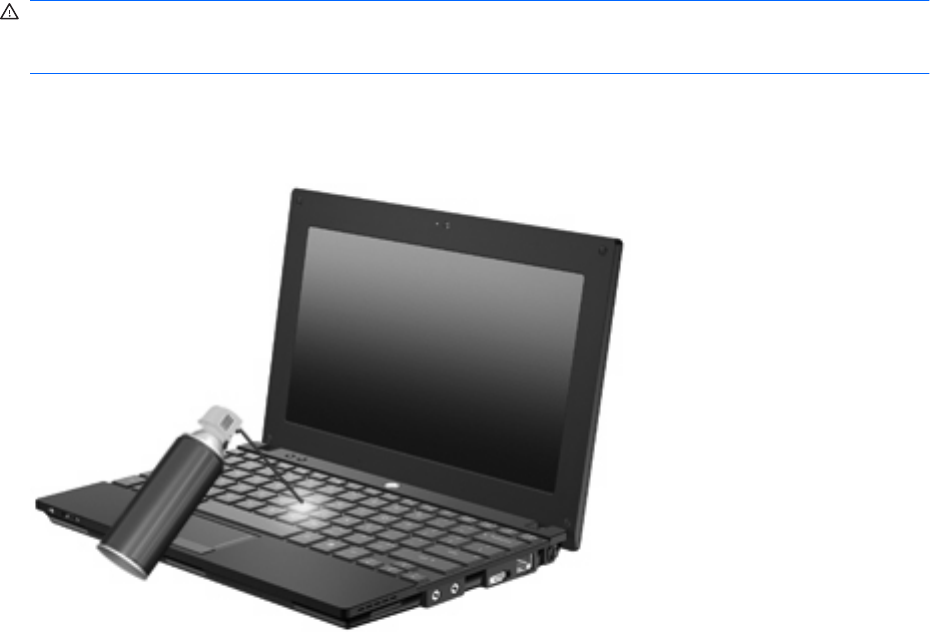
Cleaning the TouchPad and keyboard
Dirt and grease on the TouchPad can cause the pointer to jump around on the screen. To avoid this,
clean the TouchPad with a damp cloth, and wash your hands frequently when using the computer.
WARNING! To reduce the risk of electric shock or damage to internal components, do not use a
vacuum cleaner attachment to clean the keyboard. A vacuum cleaner can deposit household debris on
the keyboard surface.
Clean the keyboard regularly to prevent keys from sticking and to remove dust, lint, and particles that
can become trapped beneath the keys. A can of compressed air with a straw extension can be used to
blow air around and under the keys to loosen and remove debris.
Cleaning the TouchPad and keyboard 81

9Drives
Identifying installed drives
To view the drives installed on the computer, select Start > My Computer.
On models with a secondary hard drive (drive D), the optical drive becomes drive E. The next drive
added to the system, such as a new USB drive, will be assigned the next available drive letter.
Handling drives
Drives are fragile computer components that must be handled with care. Refer to the following cautions
before handling drives. Additional cautions are included with the procedures to which they apply.
82 Chapter 9 Drives

CAUTION: To reduce the risk of damage to the computer, damage to a drive, or loss of information,
observe these precautions:
Before you move a computer that is connected to an external hard drive, initiate Standby and allow the
screen to clear, or properly disconnect the external hard drive.
Before handling a drive, discharge static electricity by touching the unpainted metal surface of the drive.
Do not touch the connector pins on a removable drive or on the computer.
Handle a drive carefully; do not drop a drive or place items on it.
Before removing or inserting a drive, shut down the computer. If you are unsure whether the computer
is off, in Standby, or in Hibernation, turn the computer on and then shut it down through the operating
system.
Do not use excessive force when inserting a drive into a drive bay.
Do not type on the keyboard or move the computer while an optional optical drive is writing to a disc.
The write process is sensitive to vibration.
When the battery is the only source of power, be sure that the battery is sufficiently charged before
writing to media.
Avoid exposing a drive to temperature or humidity extremes.
Avoid exposing a drive to liquids. Do not spray the drive with cleaning products.
Remove media from a drive before removing the drive from the drive bay, or traveling with, shipping, or
storing a drive.
If a drive must be mailed, place the drive in a bubble-pack mailer or other suitable protective packaging
and label the package “FRAGILE.”
Avoid exposing a drive to magnetic fields. Security devices with magnetic fields include airport walk-
through devices and security wands. The airport security devices that check carry-on luggage, such as
conveyor belts, use X-rays instead of magnetism and will not damage a drive.
Handling drives 83
Improving hard drive performance
Using Disk Defragmenter
As you use the computer, files on the hard drive become fragmented. Disk Defragmenter consolidates
the fragmented files and folders on the hard drive so that the system can run more efficiently.
To run Disk Defragmenter:
1. Select Start > All Programs > Accessories > System Tools > Disk Defragmenter.
2. Under Volume, click the listing for the hard drive, usually listed as (C:), and then click
Defragment.
For additional information, access the Disk Defragmenter online Help.
Using Disk Cleanup
Disk Cleanup searches the hard drive for unnecessary files that you can safely delete to free up disk
space and help the computer to run more efficiently.
To run Disk Cleanup:
1. Select Start > All Programs > Accessories> System Tools > Disk Cleanup.
2. Follow the on-screen instructions.
84 Chapter 9 Drives

Using HP 3D DriveGuard (select models only)
HP 3D DriveGuard protects the hard drive by parking the drive and halting I/O requests under either of
the following conditions:
●You drop the computer.
●You move the computer with the display closed while the computer is running on battery power.
A short time after the end of one of these events, HP 3D DriveGuard returns the hard drive to normal
operation.
NOTE: Hard drives that are in an optional docking device or are connected to a USB port are not
protected by HP 3D DriveGuard.
For more information, refer to the HP 3D DriveGuard online Help.
Identifying HP 3D DriveGuard status
The drive light on the computer changes to an amber color to show that the drive is parked. To determine
whether drives are currently protected or whether a drive is parked, use the icon in the notification area,
at the far right of the taskbar:
●If the software is enabled, a green check mark is superimposed over the hard drive icon.
●If the software is disabled, a red X is superimposed over the hard drive icon.
●If the drives are parked, a yellow moon is superimposed over the hard drive icon.
If HP 3D DriveGuard has parked the drive, the computer will behave in the following ways:
●The computer will not shut down.
●The computer will not initiate Standby or Hibernation, except as described in the following Note.
NOTE: If the computer is running on battery power and reaches a critical battery level, HP 3D
DriveGuard allows the computer to initiate Hibernation.
●The computer will not activate battery alarms set on the Alarms tab in Power Options Properties.
Before you move the computer, HP recommends that you either shut it down or initiate Standby or
Hibernation.
Using HP 3D DriveGuard software
The HP 3D DriveGuard software enables you to perform the following tasks:
●Enable and disable HP 3D DriveGuard.
NOTE: Depending on your user privileges, you may not be able to enable or disable HP 3D
DriveGuard.
●Determine whether a drive in the system is supported.
●Hide or show the icon in the notification area.
Using HP 3D DriveGuard (select models only) 85
To open the software and change settings, follow these steps:
1. Double-click the icon in the notification area, at the far right of the taskbar.
– or –
Right-click the icon in the notification area, and then select Settings.
2. Click the appropriate button to change settings.
3. Click OK.
86 Chapter 9 Drives
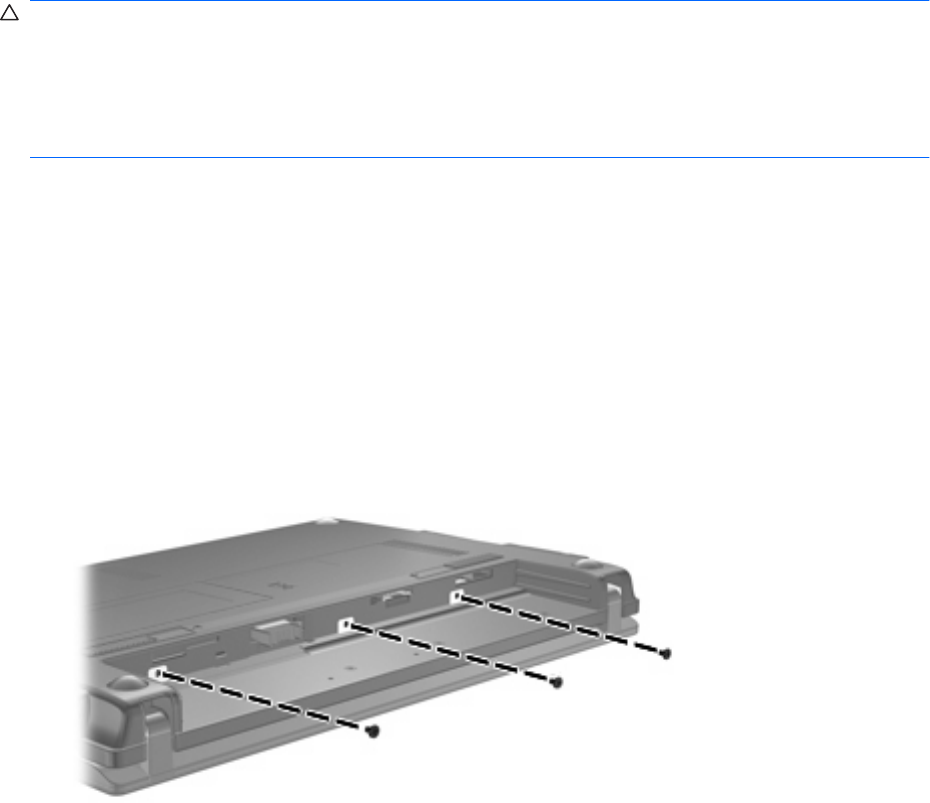
Replacing a hard drive
CAUTION: To prevent information loss or an unresponsive system:
Shut down the computer before removing the hard drive from the hard drive bay. Do not remove the
hard drive while the computer is on, in Standby, or in Hibernation.
If you are not sure whether the computer is off or in Hibernation, turn the computer on by briefly pressing
the power button. Then shut down the computer through the operating system.
To remove a hard drive:
1. Save your work.
2. Shut down the computer and close the display.
3. Disconnect all external hardware devices connected to the computer.
4. Unplug the power cord from the AC outlet.
5. Turn the computer upside down on a flat surface, with the battery bay toward you.
6. Remove the battery from the computer.
7. Remove the 3 screws from the back edge of the computer.
8. Turn the computer display-side up, with the front toward you, and open the display.
Replacing a hard drive 87
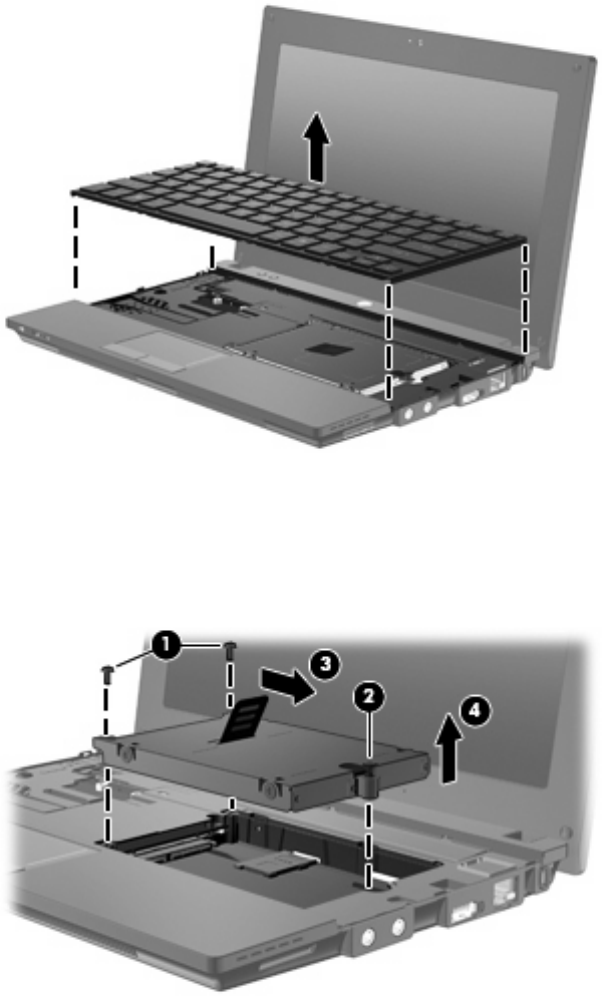
9. Lift the top edge of the keyboard up and remove the keyboard from the computer to expose the
hard drive.
10. Remove the two hard drive screws (1).
11. Loosen the captive hard drive screw (2).
12. Pull the hard drive tab (3) to the right to disconnect the hard drive, and then lift the hard drive out
of the hard drive bay (4).
To install a hard drive:
1. Insert the hard drive into the hard drive bay (1).
2. Pull the hard drive tab (2) to the left to connect the hard drive.
3. Tighten the captive hard drive screw (3).
88 Chapter 9 Drives
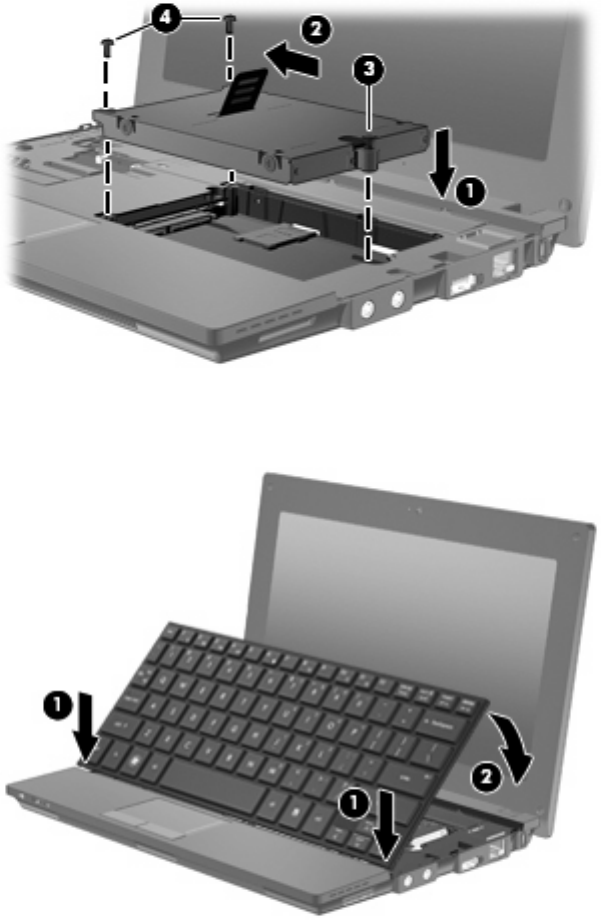
4. Replace the hard drive screws (4).
5. Insert the front edge (1) of the keyboard into the keyboard tray, and then press the keyboard into
place (2).
6. Close the computer display and turn the computer upside down on a flat surface.
Replacing a hard drive 89
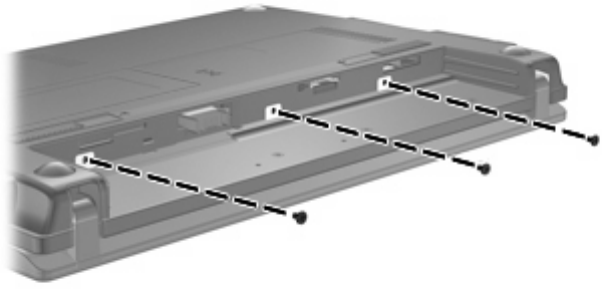
7. Replace the 3 screws on the back edge of the computer.
8. Replace the battery.
90 Chapter 9 Drives

10 Memory modules
The computer has one memory module compartment, which is located under the keyboard. The memory
capacity of the computer can be upgraded by replacing the existing memory module in the memory
module slot.
WARNING! To reduce the risk of electric shock and damage to the equipment, unplug the power cord
and remove all batteries before installing a memory module.
CAUTION: Electrostatic discharge (ESD) can damage electronic components. Before beginning any
procedure, be sure that you are discharged of static electricity by touching a grounded metal object.
To add or replace a memory module:
1. Save your work.
2. Shut down the computer and close the display.
If you are not sure whether the computer is off or in Hibernation, turn the computer on by briefly
pressing the power button. Then shut down the computer through the operating system.
3. Disconnect all external devices connected to the computer.
4. Unplug the power cord from the AC outlet.
5. Turn the computer upside down on a flat surface.
6. Slide the battery latch (1) to release the battery from the computer.
7. Remove the battery from the computer.
8. Slide the battery latch again, and the memory module compartment cover pops open.
91
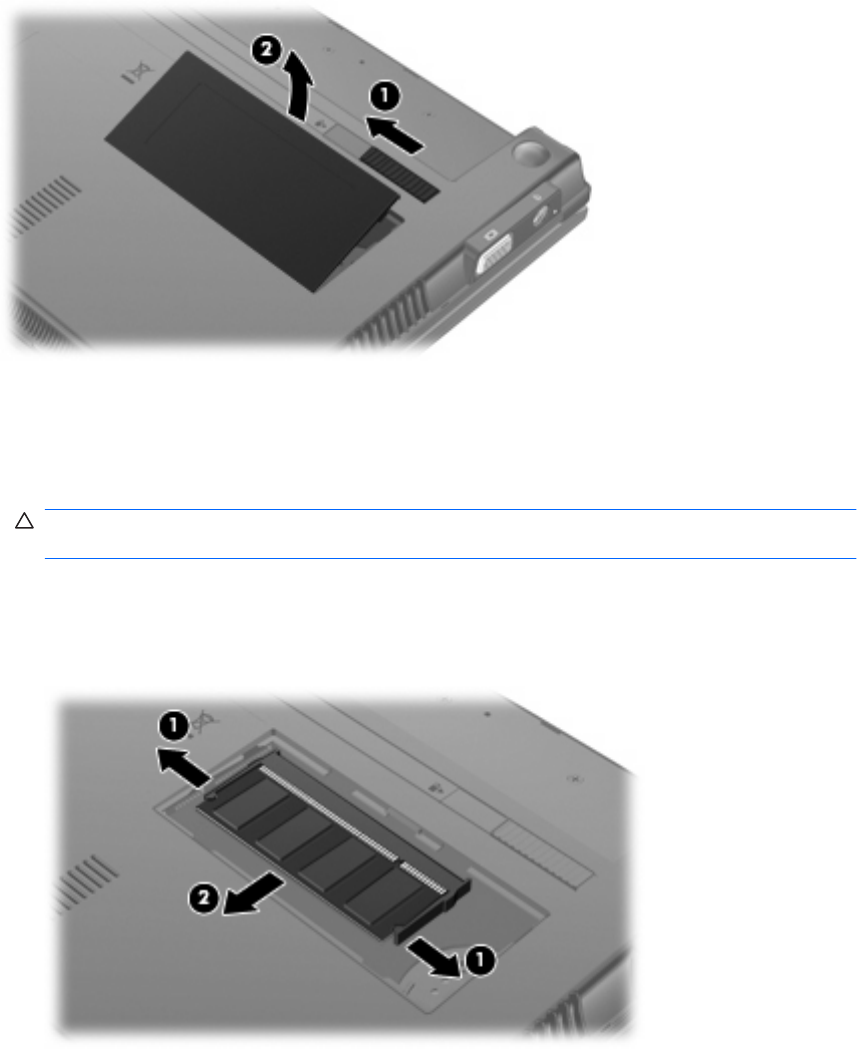
9. Remove the memory module compartment cover (2).
10. Remove the existing memory module:
a. Pull away the retention clips (1) on each side of the memory module.
The memory module tilts up.
CAUTION: To prevent damage to the memory module, hold the memory module by the
edges only. Do not touch the components on the memory module.
b. Grasp the edge of the memory module (2), and gently pull the module out of the memory
module slot.
To protect a memory module after removal, place it in an electrostatic-safe container.
11. Insert a new memory module:
92 Chapter 10 Memory modules
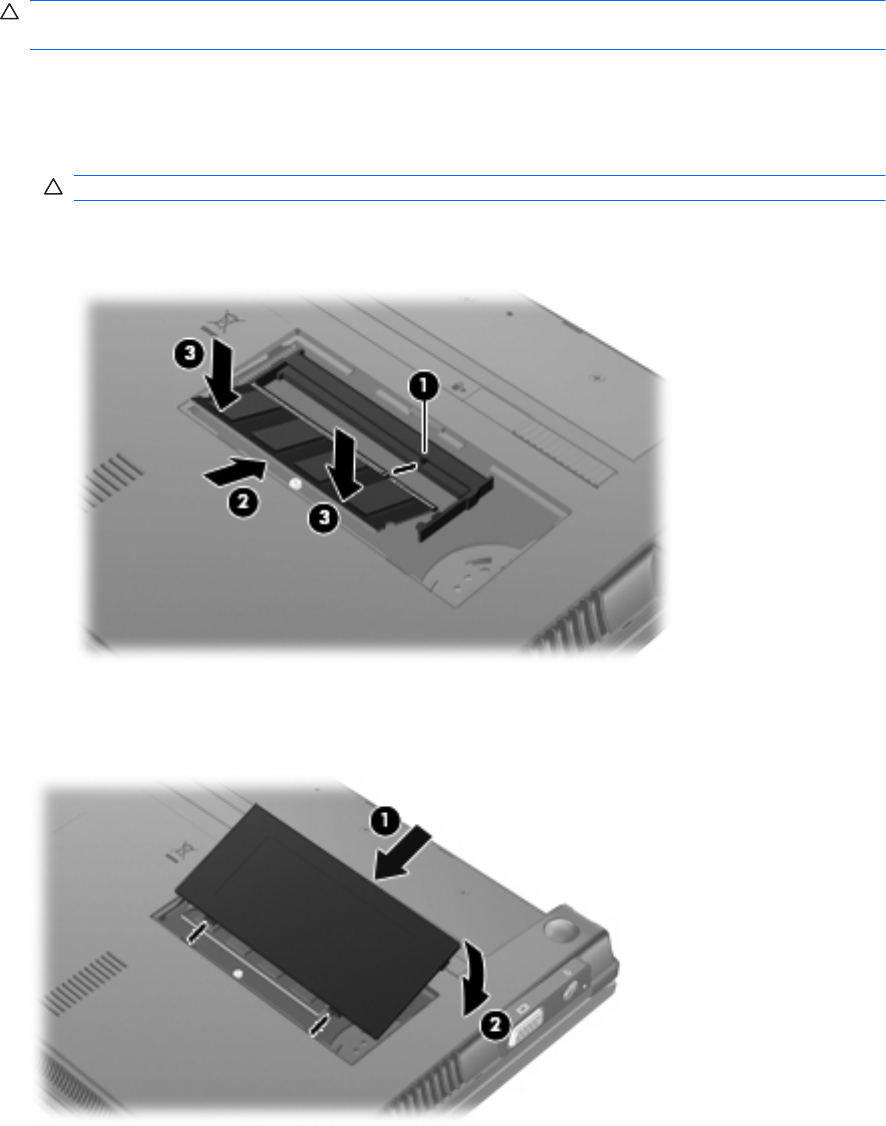
CAUTION: To prevent damage to the memory module, hold the memory module by the edges
only. Do not touch the components on the memory module.
a. Align the notched edge (1) of the memory module with the tab in the memory module slot.
b. With the memory module at a 45-degree angle from the surface of the memory module
compartment, press the module (2) into the memory module slot until it is seated.
CAUTION: To prevent damage to the memory module, do not bend the memory module.
c. Gently press the memory module (3) down, applying pressure to the left and right edges of
the memory module, until the retention clips snap into place.
12. Insert the tabs of the memory module compartment cover (1) into the notches of the compartment.
13. Press the cover down until it snaps into place (2).
14. Replace the battery.
15. Turn the computer right-side up, and then reconnect external power and external devices.
16. Turn on the computer.
93

11 Computer Setup
Starting Computer Setup
Computer Setup is a preinstalled, ROM-based utility that can be used even when the operating system
is not working or will not load.
NOTE: Some of the Computer Setup menu items listed in this guide may not be supported by your
computer.
NOTE: Pointing devices are not supported in Computer Setup. You must use the keyboard to navigate
and make selections.
NOTE: An external keyboard connected by USB can be used with Computer Setup only if USB legacy
support is enabled.
To start Computer Setup, follow these steps:
1. Turn on or restart the computer.
2. Before your operating system opens and while the “F10=ROM Based Setup” message is displayed
in the lower-left corner of the screen, press f10.
Using Computer Setup
Navigating and selecting in Computer Setup
The information and settings in Computer Setup are accessed from the File, Security, Diagnostics, and
System Configuration menus.
1. Open Computer Setup by turning on or restarting the computer, and then pressing f10 while the
"F10 = ROM Based Setup" message is displayed in the lower-left corner of the screen.
Because Computer Setup is not operating system based, it does not support the TouchPad.
Navigation and selection are by keystroke:
●To choose a menu or a menu item, use the arrow keys.
●To select an item, press enter.
●To close open dialog boxes and return to the main Computer Setup screen, press esc.
94 Chapter 11 Computer Setup

●To view navigation information, press f1.
●To change the language, press f2.
2. Select the File, Security, Diagnostics, or System Configuration menu.
3. To exit Computer Setup, choose one of the following methods:
●To exit Computer Setup without saving your preferences, use the arrow keys to select File
> Ignore changes and exit. Then follow the instructions on the screen.
●To save your preferences and exit Computer Setup, use the arrow keys to select File > Save
changes and exit. Then follow the instructions on the screen.
Your preferences go into effect when the computer restarts.
Restoring factory settings in Computer Setup
To return all settings in Computer Setup to the values that were set at the factory, follow these steps:
1. Open Computer Setup by turning on or restarting the computer, and then pressing f10 while the
"F10 = ROM Based Setup" message is displayed in the lower-left corner of the screen.
2. Use the arrow keys to select File > Restore defaults, and then press enter.
3. When the confirmation dialog box opens, press f10.
4. To save your preferences and exit Computer Setup, use the arrow keys to select File > Save
changes and exit. Then follow the instructions on the screen.
Your preferences go into effect when the computer restarts.
NOTE: Your password settings and security settings are not changed when you restore the factory
settings.
Computer Setup menus
The menu tables in this section provide an overview of the Computer Setup options.
NOTE: Some of the Computer Setup menu items listed in this chapter may not be supported by your
computer.
File menu
Select To do this
System information ●View identification information for the computer.
●View specification information for the processor, cache
and memory size, and system ROM.
Restore defaults Replace the configuration settings in Computer Setup with the
original factory settings. (Password settings and security
settings are not changed when you restore the factory settings.)
Computer Setup menus 95

Select To do this
Ignore changes and exit Cancel any changes entered during the current session. Then
exit and restart the computer.
Save changes and exit Save any changes entered during the current session. Then
exit and restart the computer. Your changes go into effect when
the computer restarts.
Security menu
NOTE: Some of the menu items listed in this section may not be supported by your computer.
Select To do this
Setup password Enter, change, or delete a setup password.
Power-on password Enter, change, or delete a power-on password.
Password options ●Enable/disable stringent security.
●Enable/disable the password requirement on computer
restart.
DriveLock passwords ●Enable, change, or disable DriveLock on any computer
hard drive.
●Enter, change, or disable DriveLock on an optional
MultiBay hard drive.
NOTE: DriveLock settings are accessible only when you
enter Computer Setup by turning on (not restarting) the
computer.
System IDs Enter a user-defined computer asset tracking number and
ownership tag.
Disk Sanitizer Run Disk Sanitizer to destroy all existing data on the primary
hard drive. The following options are available:
●Fast: Runs the Disk Sanitizer erase cycle once.
●Optimum: Runs the Disk Sanitizer erase cycle 3 times.
●Custom: Allows you to select the desired number of Disk
Sanitizer erase cycles from a list.
CAUTION: If you run Disk Sanitizer, the data on the primary
hard drive is destroyed permanently.
Diagnostics menu
Select To do this
HDD Self-Test Options Run a comprehensive self-test on any hard drive in the system
or on any optional MultiBay hard drive.
Memory Check Run a comprehensive check on system memory.
96 Chapter 11 Computer Setup

System Configuration menu
NOTE: Some of the listed System Configuration options may not be supported by your computer.
Select To do this
Language Change the Computer Setup language.
Boot options ●Set an f9, f10, and f12 delay when starting up.
●Enable/disable CD-ROM boot.
●Enable/disable floppy boot.
●Enable/disable internal network adapter boot.
●Enable/disable MultiBoot, which sets a boot order that
can include most boot devices in the system.
●Set the Express Boot Popup delay in seconds.
●Set the boot order.
◦1st boot device: USB CD-ROM
◦2nd boot device: USB floppy
◦3rd boot device: USB SuperDisk
◦4th boot device: Notebook hard drive
◦5th boot device: USB hard disk
◦6th boot device: Network controller
Device configurations ●Swap the functions of the fn key and left ctrl key.
●Enable/disable USB legacy support. When enabled, USB
legacy support allows the following:
◦Use of a USB keyboard in Computer Setup even
when a your operating system is not running.
◦Startup from bootable USB devices, including a hard
drive, diskette drive, or optical drive connected by a
USB port to the computer.
●Enable/disable BIOS DMA data transfers.
●Enable/disable fan always on while connected to an AC
outlet.
●Enable/disable data execution prevention.
●Enable/disable LAN power saving mode.
●Enable/disable SATA Native Mode.
●Enable/disable Dual Core CPU.
●Enable/disable HDD translation mode.
Built-in device options ●Enable/disable embedded WLAN Device Radio.
●Enable/disable embedded Bluetooth Device Radio.
●Enable/disable Network Interface Controller (NIC)
Computer Setup menus 97

Select To do this
●Enable/disable LAN/WLAN Switching.
●Enable/disable Wake on LAN.
●Enable/disable the integrated camera (webcam)
Port options ●Enable/disable USB port.
●Enable/disable ExpressCard slot.
98 Chapter 11 Computer Setup

12 Backing up and recovering
To protect your information, use the Windows® Backup utility to back up files and folders or create
recovery points. In case of system failure, you can use the backup files to restore your computer.
NOTE: Windows Backup utility is available only on the notebooks with the Windows XP Professional
operating system. If your notebook has Windows XP Home, you can back up your personal files to a
USB external hard drive (purchased separately).
Windows XP Professional provides the following advanced backup and recovery options:
●Backing up individual files and folders
●Backing up all files and folders
●Scheduling automatic backups (select models only)
●Scheduling automatic backups
●Creating recovery points
●Recovering information
NOTE: For instructions on these procedures, go to Help and Support.
99
Backing up
Recovery after a system failure is as complete as your most current backup. You should create your
initial backup immediately after software setup. As you add new software and data files, you should
continue to back up your system on a regular basis to maintain a reasonably current backup.
In Windows XP Professional, use the Windows Backup utility to create a backup. Click Start > All
Programs > Accessories > System Tools > Backup. Follow the on-screen instructions to back up
your files.
In Windows XP Home, copy data files to a USB external hard drive (purchased separately).
100 Chapter 12 Backing up and recovering

Recovering
In case of system failure or instability, use the Operating System disc and the Driver Recovery discs
that are included with the computer to recover your operating system and programs.
CAUTION: The recovery process reformats and completely erases the hard drive. All files you have
created and any software installed on the computer are permanently removed. The recovery process
reinstalls the original operating system as well as software and drivers. Software, drivers, and updates
not installed by HP must be manually reinstalled. Personal files must be restored from a backup.
1. If possible, back up all personal files.
2. Shut down the computer.
3. Insert the Operating System disc into an optional external optical drive.
4. Turn on the computer.
5. Follow the on-screen instructions to install the operating system.
6. After the operating system is installed, remove the Operating System disc and insert the Driver
Recovery disc.
7. Follow the on-screen instructions to install the drivers and programs.
NOTE: For additional information, go to Help and Support.
Recovering 101

Index
A
AC adapter
connecting 16
identifying 10
administrator password 49
airport security devices 83
antennas 9
applications key, Windows 5
audio devices, connecting
external 38
audio functions, checking 38
audio-in (microphone) jack 6, 35
audio-out (headphone) jack 6,
35
B
backing up 99, 100
battery
calibrating 20
charging 18, 20
conserving power 22
disposing 23
inserting 17
low battery levels 19
recharging 22
removing 17
replacing 23
storing 22
battery bay 9, 11
battery charge, maximizing 19
battery light 18, 19
battery power 16
battery release latches 17
battery release latches,
identifying 9
battery temperature 22
battery, identifying 10
bays, battery 11
Bluetooth device 25
Bluetooth label 11
boot options 97
boot order 97
button, volume mute 35
buttons
power 4
Quick Launch Mail 4
Quick Launch Web 4
TouchPad 2
C
cables
USB 67
calibrating battery 20
caps lock light, identifying 3
CD
inserting 42, 70
removing 45, 71
CD drive 41, 69
Certificate of Authenticity label 11
charging batteries 18, 20
checking audio functions 38
components
additional hardware 10
bottom 8
display 8
front 5
left-side 7
right-side 6
top 1
Computer Setup
device security 60
Diagnostic menu 96
DriveLock password 55
File menu 95
navigating and selecting 94
power-on password 52
restoring factory settings 95
Security menu 96
setup password 50
stringent security 60
System Configuration
menu 97
connecting to a WLAN 29
Connection Manager icon 25
connection, external power 16
connector, power 7
conservation, power 22
cord, power 10
corporate WLAN connection 29
critical battery level 19
D
device security 60
Diagnostic menu 96
digital card
inserting 74
removing 75
stopping 75
Disk Cleanup software 84
Disk Defragmenter software 84
disk performance 84
diskette drive 69
display
image, switching 78
screen brightness keys 78
display components 8
drive light 5, 85
drive media 12
DriveLock password
changing 58
description 55
entering 57
removing 59
setting 56
drives
diskette 69
external 69
hard 69, 88
102 Index
MultiBay 69
optical 69
drives, boot order 97
drives, optical drive 41
DVD
changing region setting 44
inserting 42, 70
removing 45, 71
DVD drive 41, 69
DVD region settings 44
E
earbuds 35
embedded numeric keypad keys,
identifying 5
encryption 28
esc key, identifying 5
external audio devices,
connecting 38
external drive 69
external monitor port 40
external monitor port,
identifying 7
F
File menu 95
firewall 28
fn key, identifying 5
function keys
decreasing screen
brightness 78
increasing screen
brightness 78
increasing speaker volume 79
initiating QuickLock 78
initiating Sleep 78
muting speaker sound 79
switching screen image 78
function keys, identifying 5
H
hard disk drive
external 69
HP 3D DriveGuard 85
installing 88
hard drive
external 69
HP 3D DriveGuard 85
installing 88
hardware, identifying 1
headphone (audio-out) jacks 35
headphones 35
Hibernation
exiting 13
initiated during critical battery
level 19
initiating 13
HP 3D DriveGuard 85
HP Mobile Broadband Module 30
HP Mobile Broadband,
disabled 30
hubs 67
I
icons
Connection Manager 25
network status 25
wireless 25
internal microphone,
identifying 35
internal microphones,
identifying 8
Internet connection setup 27
J
jacks
audio-in (microphone) 6, 35
audio-out (headphone) 6, 35
RJ-45 (network) 6
K
keyboard function keys,
identifying 76
keypad, embedded
enabling and disabling 80
identifying 79
switching key functions 80
using 79
keypad, external
num lock 80
using 80
keys
decreasing speaker sound 79
esc 5
fn 5
function 5
keypad 5
Windows applications 5
Windows logo 5
L
labels
Bluetooth 11
Microsoft Certificate of
Authenticity 11
regulatory 11
service tag 9, 10
wireless certification 11
WLAN 11
latches, battery release 9
legacy support, USB 94, 97
light, drive 85
lights
caps lock 3
drive 5
power 3, 7
Quick Launch Mail 3
Quick Launch Web 3
webcam 8, 35
wireless 6
low battery level 19
M
maintenance
Disk Cleanup 84
Disk Defragmenter 84
memory module
inserting 92
removing 92
memory module compartment,
identifying 9
microphones, internal 8, 35
Microsoft Certificate of Authenticity
label 11
monitor port, external 7
monitor, connecting 40
mouse, external
connecting 76
setting preferences 76
movie, watching 43
MultiBay 69
multimedia components,
identifying 34
multimedia software 37
MultiMediaCard 74
mute button 35
N
network status icon 25
num lock, external keypad 80
Index 103
O
operating system
Microsoft Certificate of
Authenticity label 11
Product Key 11
optical disc
inserting 42, 70
removing 45, 71
optical discs, using 41
optical drive 41, 69
P
passwords
administrator 49
DriveLock 55
power-on 52
setup 50
user 49
pointing devices
setting preferences 76
ports
external monitor 7, 40
USB 6, 7, 67
power
connecting 16
conserving 22
power button, identifying 4
power connector, identifying 7
power cord, identifying 10
power light 7
power light, identifying 3
Product Key 11
product name and number,
computer 9, 10
projector, connecting 40
public WLAN connection 29
Q
Quick Launch Mail light,
identifying 3
Quick Launch Mail, identifying 4
Quick Launch Web button,
identifying 4
Quick Launch Web light,
identifying 3
QuickLock key 78
R
readable media 12
recovering 99, 101
region codes, DVD 44
regulatory information
regulatory label 11
wireless certification labels 11
release latches, battery 9
RJ-45 (network) jack,
identifying 6
S
screen brightness keys 78
screen image, switching 78
scrolling regions, TouchPad 2
SD Card 74
SD Card Reader 6, 74
security cable slot, identifying 6
Security menu 96
security, wireless 27
serial number, computer 9, 10
service tag 9, 10
setup of WLAN 27
setup utility
Diagnostic menu 96
File menu 95
restoring factory settings 95
Security menu 96
System Configuration
menu 97
setup, computer 1
shut down 24
SIM
inserting 30
removing 31
Sleep key 78
slots
security cable 6
software
Disk Cleanup 84
Disk Defragmenter 84
speakers 35
speakers, identifying 6, 8
Standby
exiting 12
initiating 12
storing battery 22
stringent security 60, 96
switches
wireless 6
System Configuration menu 97
system fan 97
system information 95
system information key 5
T
temperature 22
TouchPad
buttons 2
identifying 1
scrolling regions 2
using 76
traveling with the computer 11,
22
turning off the computer 24
U
unresponsive system 24
USB cable, connecting 67
USB devices
connecting 67
description 67
removing 67
stopping 67
USB hubs 67
USB legacy support 68, 94, 97
USB port, powered 69, 70
USB ports, identifying 6, 7, 67
user password 49
V
vents, identifying 7, 9
video transmission types 78
video, recording 8
volume keys 35
volume mute button 35
volume, adjusting 35
W
webcam 8, 35
webcam light, identifying 8, 35
webcam properties, adjusting 47
Windows applications key,
identifying 5
Windows logo key, identifying 5
wireless antennas 9
wireless certification label 11
wireless controls
button 26
operating system 26
wireless icon 25
wireless light 6, 26
wireless network (WLAN)
connecting 29
corporate WLAN
connection 29
104 Index
